
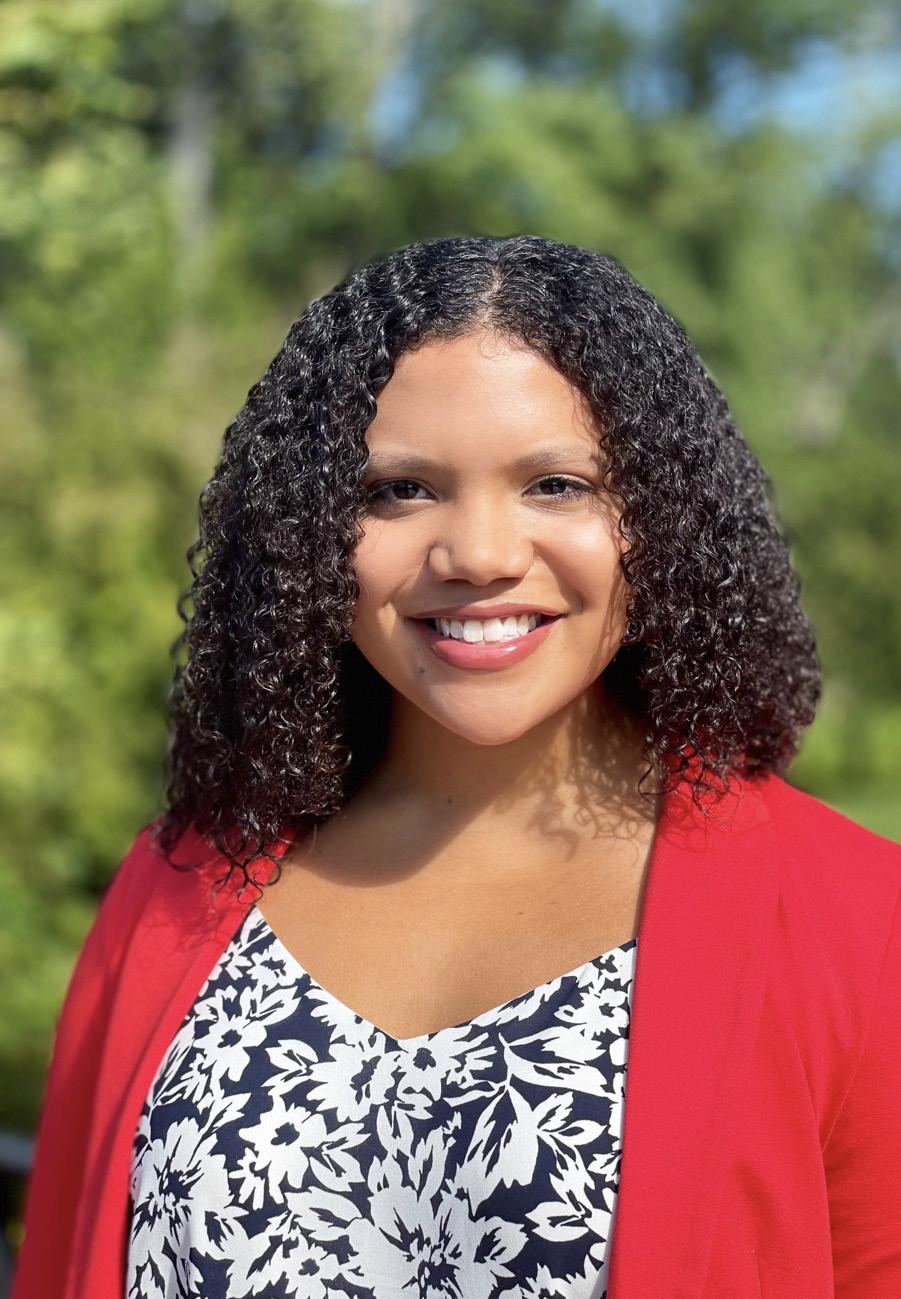 Maya Meade | Editor-in-Chief backdropmag@gmail.com
Maya Meade | Editor-in-Chief backdropmag@gmail.com


 Maya Meade | Editor-in-Chief backdropmag@gmail.com
Maya Meade | Editor-in-Chief backdropmag@gmail.com
Hello,
Wow. What a year it has been. Words can’t even begin to describe the experience that I have had as editor-in-chief of Backdrop. I am incredibly thankful for the people on my staff that have made it through a lot of challenges and produced four issues of our magazine.
I would not be the person who I am today if I didn’t get to hold this leadership position. I learned more than I ever thought I could and have poured all of my love and energy into this organization. Additionally, I have made some of the best friends I have ever had.
I will never forget the nights that managing editor, Helen Widman, and I spent talking about all the ups and downs and goods and bads of the magazine. Starting this job, I never would have thought that she would be someone I can’t live without. I am so excited to see the future of Helen’s journalism career and hope we can support each other as Backdrop alumni for years to come.
Thank you to all of my current executive members and the incoming executive staff. I wish the best of luck to Sophia Englehart as she graduates this spring. I thank Rachel Rector and Ellie Habel for being amazing role models for our designers and photographers and for continuing on our executive board for next year.
I am so excited to see the amazing work that Mia Walsh will do with Backdrop as next year’s editor-in-chief. With Caroline Bissonnette and McKenna Christy by her side as her managing and assistant managing editors, I only imagine their magazines will be a success.
I am hopeful that they will continue to promote our mission of diversity in journalism and share the voices of the voiceless in our region of Ohio. I can’t wait for you all to read our last issue of the year and thank our readers for continued support.

Best,

Backdrop magazine is an award-winning, student-run magazine aimed at covering current events and culture with OU and Athens as our "Backdrop." We are currently recruiting more people to join our amazing staff. We have positions available for:
• Writers
• Photographers
• Designers
• Social Media Content Creators
• And more!
If you're interested in joining our team, email backdropmag@gmail.com
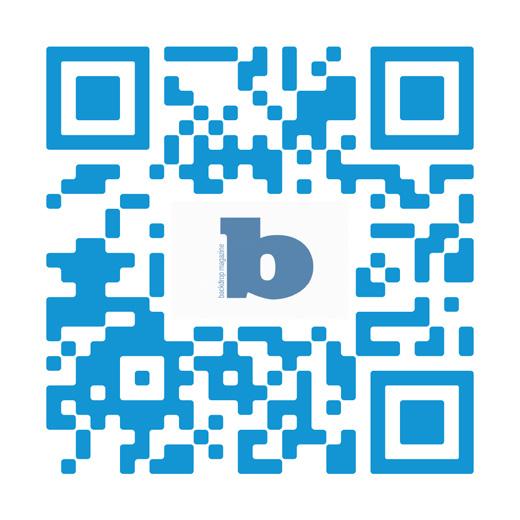
EDITOR-IN-CHIEF MAYA MEADE
MANAGING EDITOR HELEN WIDMAN
WEB EDITOR JOSIE DONOHUE
COPY EDITORS CAROLINE BISSONNETTE, MCKENNA
CHRISTY, MIMI CALHOUN, SOPHIA ENGLEHART, GRACE KOENNECKE, MOLLY POWERS
ASSOCIATE EDITORS DYLAN BENEDICT, MCKENNA
CHRISTY, SOPHIA ENGLEHART, CAROLINE GILLEN
MARKETING DIRECTORS CAROLINE BISSONNETTE, MICKEY RUIZ
SOCIAL MEDIA DIRECTOR SARAH TODACK
PHOTO EDITOR ELLIE HABEL
CREATIVE DIRECTOR RACHEL RECTOR
ART DIRECTOR BROOKE GARRETT
DESIGNERS DREW FOLLMER, BROOKE GARRETT, JULIA GREENWOOD, KATE RECTOR, RACHEL RECTOR, JOSIE RILEY
PHOTOGRAPHERS DYLAN BENEDICT, JACOB DURBIN, AZIZ AL FADHA, ELLIE HABEL, AHMED HAMED, PEARL SPURLOCK, JOE TIMMERMAN
WRITERS RORY BALL, CAROLINE BISSONNETTE, MCKENNA CHRISTY, JOSIE DONOHUE, SOPHIA ENGLEHART, CAROLINE GILLEN, ADDIE HEDGES, AMBER PHIPPS, PJ MAROLT, JOE TIMMERMAN, HELEN WIDMAN
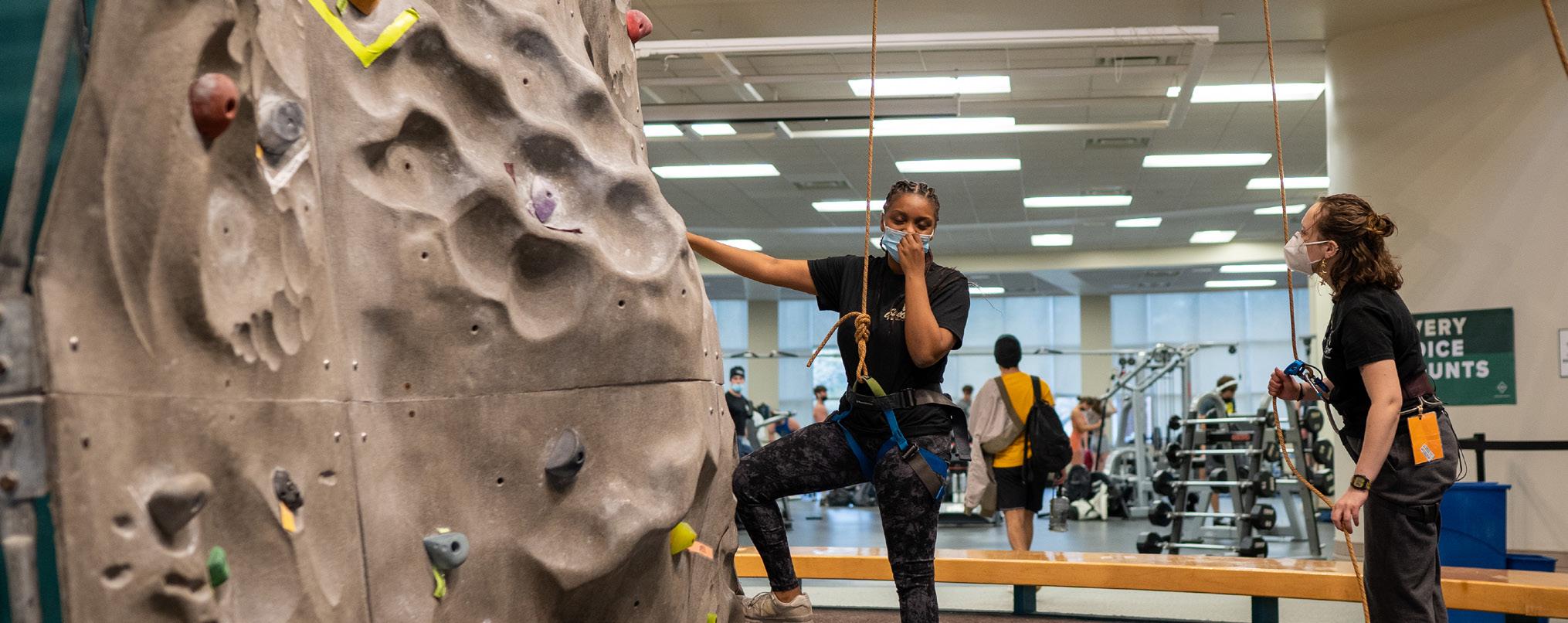
The rise in anime’s popularity isn’t just limited to Athens, but nationwide.
STORY & PHOTOS BY JOE TIMMERMAN DESIGN BY DREW FOLLMERSakura has a home in Athens. Known as cherry blossom in Japanese, sakura may sound familiar to the growing number of American anime fans, as it’s the namesake of Naruto’s pink-haired secondary character. As the famous pink and white cherry blossom buds begin to bloom across Ohio University’s campus, many students find themselves waiting for the next episode of their favorite anime show. While seemingly disconnected, cherry blossoms and anime both find an origin in Japan and a home in Athens.
Since the beginning of the coronavirus pandemic, global demand for anime has grown 118 percent, according to Parrot Analytics, which gathers data by measuring video streaming and downloads, social media engagement


such as hashtags, likes and sharing and research actions such as online browsing or writing about shows.
At the end of 2020, Netflix reported that “over 100 million households around the world chose to watch at least one anime title in Netflix,” since the end of 2019 — growing by 50 percent since the year before.
“30 years ago, when I started teaching Japanese and Japan anthropology classes and taking Americans to Japan, people were scholars; they wanted to be college professors, translators or diplomats, they wanted to learn Japanese for the purpose of reaching advance levels of proficiency,” Christopher Thompson, an associate professor of Japanese Language & Culture at OU, says.
Thompson, who was born in Japan and spent the first 18 years of his life there before moving to America, continues to travel there up to three times a year and finds that 30 to 50 percent of the students taking his classes are taking it because of their interest in animation.
“My typical experience is that students come into our language classes and culture classes these days because they’re interested in media representations of Japan and they end up finding other little niches they never knew about that are even more interesting to them …
that’s the power of manga and anime,” Thompson says.
Jack Wire, a junior studying music production at OU and student in Thompson’s Japanese culture class, decided to enroll in the class after watching anime shows such as Neon Genesis Evangelion and Serial Experiments Lain.
“I started watching more anime because a lot of the music I listen to has anime samples or the album cover is anime,” Wire says. “I want[ed] to learn more about Japanese culture.”
Wire says since enrolling in Thompson’s class, he’s gained a better cultural understanding of what’s happening in the anime shows he watches or manga he reads.
“When I was ten or eleven, my parents went to Japan,” Wire says. “I’ve been wanting to go since then.”
Another way OU introduces American students to Japanese culture and introduces Japanese students to American culture is through its ongoing relationship with Chubu University. Chubu University, OU’s sister school in Japan, gifted Athens its now-beloved cherry trees in 1979. Since then, the two universities have exchanged both students and faculty, including 46 Japanese students who are currently
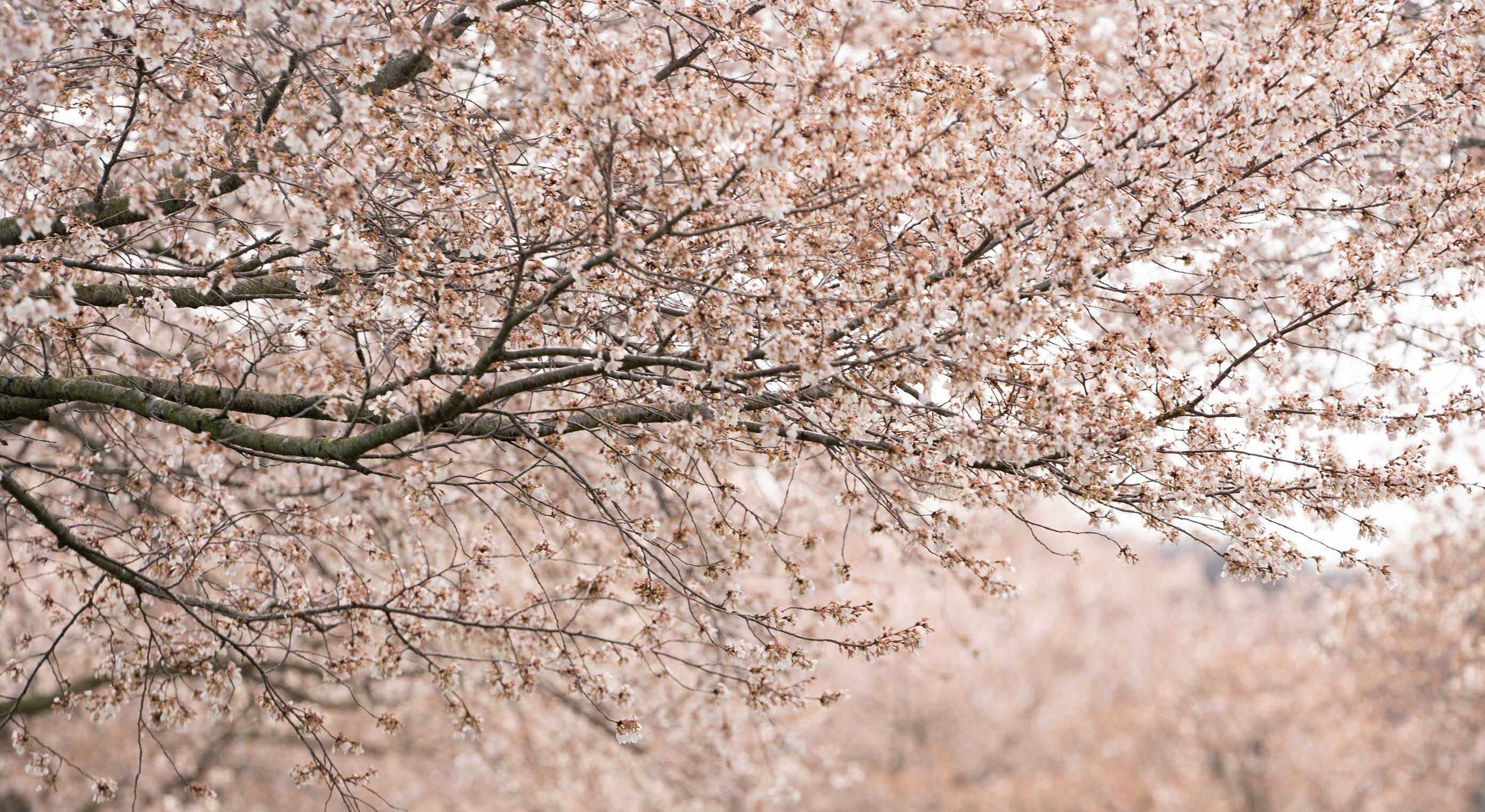
in Athens for a spring semester study abroad experience.
“We like to make sure people get an accurate view of what [Japanese culture] really is,” Thompson says.
Sota Mizuno, a 19-year-old student at Chubu University, is currently in Athens participating in the study abroad program. Mizuno came to Athens because he wants to learn about American culture, he says, just as the OU students like Wire want to learn about Japanese culture.
“Japanese culture is so unique, [Americans] should watch anime so they can learn,” Mizuno says.
As anime’s popularity continues to grow, the consumption of Japanese graphic novels, known as manga, has risen as well. According to NPD Bookscan, which covers approximately 85 percent of the United States trade print book market, U.S. manga sales more than doubled, going up 15 million units since 2020 to 24.4 million units in 2021.
Nicholas Polsinelli, the owner of Little Professor Book Center on Court Street, has seen the same trend within the OU student population that shop at his store. Currently, the store has 100 new manga books and another 20 to 30 used manga books.
“We’ve seen a ton of college students interested in getting manga,” Polsinelli says. “Younger people as well, in high school or even middle school are starting to read more manga than we’re used to.”
Austin Vega, a junior at OU works at Little Professor Book Center. Polsinelli says Vega initially suggested that the Little Professor Book Center should stock more manga and goes to him to learn about what series are popular and exciting.
“It’s its own unique style of reading,” Vega says as he stacks manga books on the brand-new wooden shelves during his afternoon shift at the bookstore. “You’re going to see things that you wouldn’t normally experience.”
When the Little Professor Book Center started stocking manga again, JoJo’s Bizarre Adventure was the first series they carried.
“As we got that, more people bought it so now we carry tons of different series by tons of different authors,” Vega says. “And we have people who come here just for manga.”
The popularity in manga has not gone unnoticed by Polsinelli.
“I think the last time we had this level of interest from manga was before I owned the store. It was probably 15 years ago,” Polsinelli says. “It has definitely been on
the rise since I think 2019.”
As the sakura bloom along the Hocking River, Japanese culture extends its roots further across Athens and across the U.S. Americans are discovering little slices of Japanese life, whether they know it or not, through new anime episodes they stream online, freshly printed copies of manga they pick up at bookstores and through the covers of albums they listen to.
While Thompson says, “To think manga itself is a clear representation of Japanese culture would be a mistake,” this wondrous art style serves as a portal for many Americans. Anime and manga have the power to offer small pieces of cultural understanding to those who may otherwise never be exposed to Japanese culture.
“It takes us out of such a singular world view,” Vega says. b

Rumors about Ohio University circulate as several changes of life are made for students: Classes from several departments have become unavailable, there is reduced staffing and general revenue has been declining for a few years now.
OU announced on May 15, 2020, that they were letting go of more than 50 faculty members and more than 140 administrators which is what might have caused many to be frustrated with how OU has handled being in financial need. Students have been left questioning how this is possible.
Kristin Leibensperger, an OU freshman studying physics and French, says that the modern language department can only offer two upper level French courses right now and that it is difficult to schedule them.
“What makes it all frustrating is seeing money being wasted in various locations; a big example being the stickers that they put up across campus,” Leibensperger says. “Yes, I fully understand that to get enrollment up, you have to make the campus attractive; but the stickers do not look good and they are widely expensive. That money could have gone to something useful.”
Other language departments have also felt the effects
of the university’s budget cuts. Andy Chrvala is a senior studying both German and history.
“Ohio University’s budget cuts have drastically affected me both personally and educationally as a language major. With a large staff in the German program when I came here, I felt like I was welcomed into a family,” Chrvala says. “A family that had lots of things to teach me and help me along my path in my chosen language. Due to budget cuts I lost many members of that family and not only are those people instructors for me but they’re also people I can lean on and talk to about issues that I’m having in my life.”
Chrvala also says that he would have done things differently if he’d known what he does now about the current state of the department.
“… I probably wouldn’t have pursued this path. Not to mention that amount of workload that falls on the shoulders of small numbers of professors that they don’t necessarily have to do but they do for the language majors,” Chrvala says.
Compared to today’s OU, there was a more abundant selection of classes to choose from in years past, staffing was higher and the coronavirus wasn’t a household
name. However, this marked the year that kickstarted the pandemic, and many attribute this to be why OU lost a significant number of students and revenue.
Freshman Alexis Rohrer, who is undecided in her major, also feels upset about the situation.
“I find it disheartening that we have had to let go of some amazing professors and take hits to our financials in so many different areas. I think that because we are losing such valuable resources for the school, we are not getting the same value of education or overall experience that students have had before us,” Rohrer says.
However, the university reassures students that despite the changes they have experienced, OU maintains a strong financial status.
Is OU in financial trouble? According to interim Vice President for Finance and Administration Joe Trubacz and Associate Provost for Academic Budget and Planning John Day, it is not.
When asked if students had to worry about OU’s finances, they said in a joint statement, “Ohio University is financially strong with very healthy reserves that will allow us flexibility in times where we must address imbalances between revenues and expenses created by shifts in enrollments.”
Essentially, OU has money saved up for unprecedented times like the pandemic so they can get any financial troubles sorted out. The question is, will they?
Ellen Gill, an OU senior studying English pre-law and sociology-criminology, seems hopeful for the future of OU’s financial situation. Gill is a student trustee, has actively participated in budget meetings and is on the Budget Planning Council.
“I am optimistic about the financial status of Ohio University as a result of our substantial reserves, comparatively strong financial position in the state, and recent efforts to better forecast revenue and expenses,” Gill says.
As for her reasoning, she says, “My optimism is reinforced by increasing first-year enrollment and the
substantial federal funding that offset COVID-19 related expenses. While we are still operating in a financial deficit, the changes being made right now provide an opportunity to right-size departmental budgets and prepare for a predictable financial future.”
Gill has advice for fellow students who may be frustrated with OU and its finances.
“I advise students to take advantage of the financial reports available to them. While President Sherman and Interim Vice President Trubacz can answer their questions, so can their chief financial administrative officer, their dean, and their student trustees,” Gill says. “In order to most efficiently hear concerns and act upon them, students should go to the person most able to enact local change and move those concerns upward.”
A significant part of the concerns from students is the uncertainty surrounding where the financial revenue actually goes at OU. When asked about the topic, Day said that all revenues are, “pooled together,” and that one can’t specifically say where a particular student’s tuition money went. Trubacz added that some other entities, like Housing and Residence and Culinary Services, have separate budgets.
Despite any disagreements regarding the university’s financial standings, it is evident that the budget cuts are impacting the lives of students. The departments that have taken hits will likely continue to struggle as time goes on, potentially leading to more departments closing down, thus eliminating further majors.
All in all, money is a heavily discussed topic for OU right now. The cause of students’ problems relies on what OU is doing to lift itself out of financial concern, which would be the aforementioned cuts to programs, faculty and the general OU way of life.
Regardless of if these cuts are made to perhaps underused or underappreciated things, the power remains with the students to decide what aspects of OU make it a great university. b
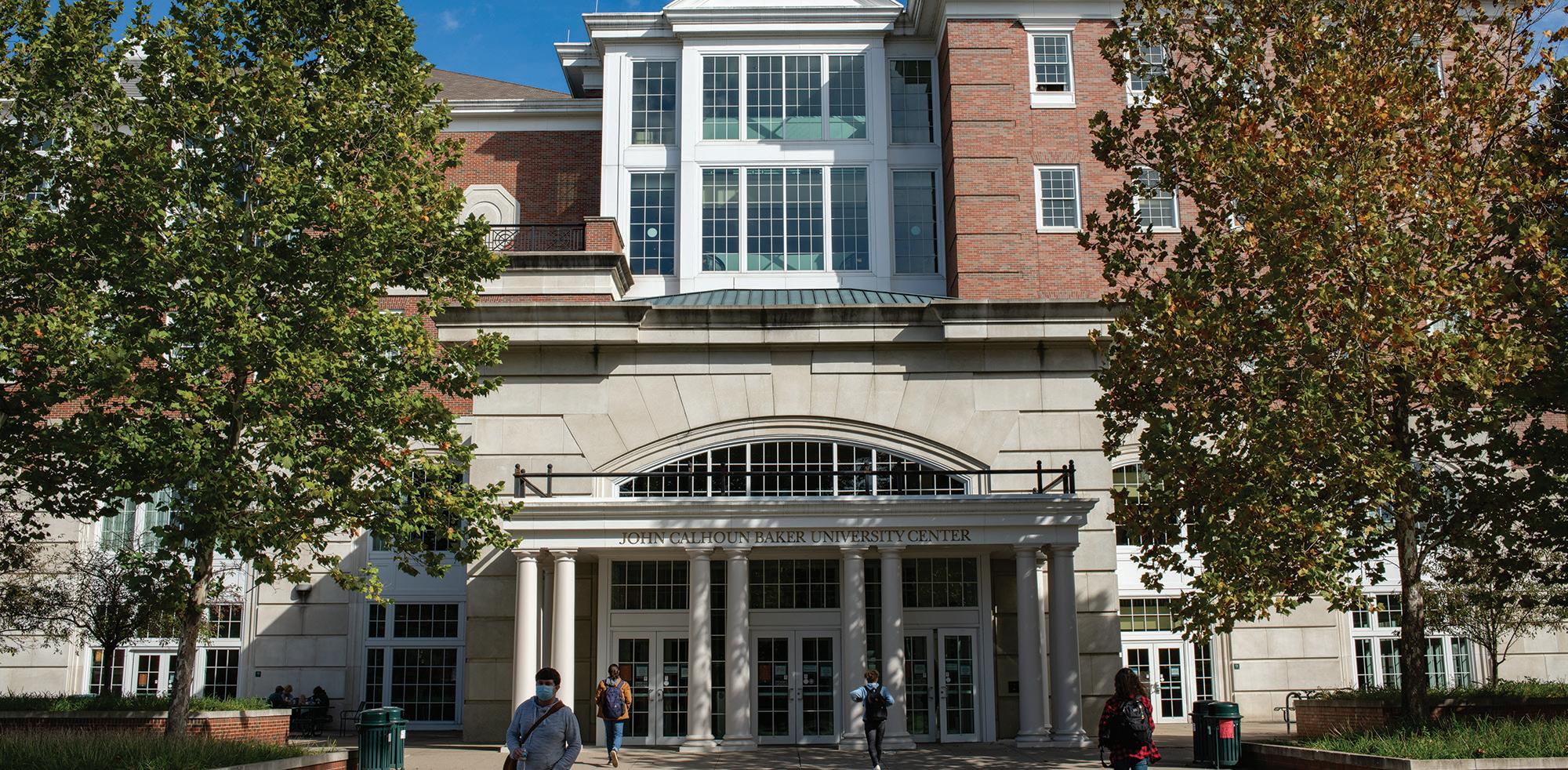
The Davidson family transformed their grandparent’s farm into the Hocking Hills Winery and provide a cozy experience for visitors in the area.

While the soil of the Hocking Hills Winery may not contain the roots of grapevine trees, it does hold the memories of one family’s history. The Davidson family farm occupied the land long before the winery came to be.
Blaine Davidson, CEO of Hocking Hills Winery, and an alumnus of Ohio University, spent summers and many weekends at his grandparent’s farm growing up. Davidson developed a love for the land and his time on the farm.
The land has been in the Davidson family since the 1960s, which is when Max and Loris Davidson moved to the area. The acres the winery now sits on were a cattle farm until the early 1990s. When Max and Loris Davidson died, the rest of the family thought about what to do with the farm.
“We didn’t want to sell it,” Davidson says. “We wanted to hang on to it and we wanted to maintain the agricultural status of the land.”
When a proposal of what to do with the land struck one of the family members, Davidson wanted to make it a reality. “So, we were just kind of sitting around, trying to come up with an idea of what to do with it all and came up with this idea of a vineyard and it sounded really cool at the time,” Davidson says.
Davidson wrote a business plan for the vineyard in an entrepreneurship class he took for his MBA and presented the plan to the rest of his family. Davidson’s family loved the idea and the work to create a vineyard began.
In 2008, the Davidsons planted one acre of grapes and another two acres in 2009. They quickly realized that growing grapes can be a lot of work. The Davidson’s original plan was to grow the grapes and sell them to wineries, but they discovered that business plan was not cost efficient.
The Davidsons then started thinking about the number of visitors that come to Hocking Hills each year. To get to Hocking Hills, people must drive past the Davidson’s land, which inspired Blaine to ask the rest of the family about opening a winery. The family began planning the winery in 2012 and opened their doors in April 2015 at 30402 Freedman Rd. in Logan, Ohio.
Part of Hocking Hills Winery’s goal is to be laid back and make room for all types of visitors.
“We want you to feel comfortable whether or not you’re coming in from the hiking trails or canoeing or you’re coming home from a fancy dinner and want to stop by for a drink afterwards in a suit and tie,” Davidson says. “There’s no dress code, we try to make everybody feel comfortable and [be] welcoming.”
Music is another one of the attractions of the winery. During the summer and warm months, live music is played every Friday and Saturday from 6 to 9 p.m. There’s an outdoor stage for musicians to play on by the patio in the surrounding wooded area. But the music doesn’t stop when it becomes colder.
“When it’s cooler out, we kind of bring them inside and focus on the smaller acoustic acts in the winter months,” Davidson says.
Although the winery does not grow their own grapes, all the wine is made on site. Some of the grapes used to make the wine are grown or come from other wineries in Ohio. Grapes are also sourced from the West Coast and Washington. The winemakers of Hocking Hills Winery then complete the fermentation and bottling process.
The variety of sourced grapes produce fan-favorite wines.
“Our Hocking River Red is by far the best seller,”
Davidson says. “It’s a sweet red wine. On the white side, it’s probably a couple of new releases with some Ohio grapes or [our] honeysuckle is selling well, it’s a blend of three or four different Ohio grapes. It’s a sweet white.” The absolute favorite drink at the winery is, surprisingly, not a traditional glass of wine, but the cold and savory wine slushies.
“[They] sell the best out of everything,” Davidson says. “We have peach, raspberry, pink lemonade or Sangria wine slushies.”
Amy Garrett, OU parent and fan of the winery, goes to Hocking Hills Winery every chance she gets. Garrett’s first time at the winery was after she dropped her child off at OU their freshman year. The winery was the first place Garrett and her family saw, so they stopped there for some drinks and a new experience.
“It’s a nice cozy place,” Garrett says. “Nice patio outside. There’s a fire pit. There’s a patio that is enclosed, but they have it open where you can eat inside, drink inside and it’s just a real cozy place.”
The Garrett family has visited the winery seven times since their initial visit. Garrett enjoys their chardonnay and her family always get the meat and cheese platter. Garrett’s favorite memory at the winery was when she went with her family for her 50th birthday celebration. “We rented this big house [with] my husband, the kids [and] my mother-in-law,” Garrett says. “My husband’s brothers came, and we spent an afternoon [at the winery] just drinking and eating and even though it was chilly, it had those big fire [torches].”
The cozy and unforgettable atmosphere of Hocking Hills Winery is expanding. The Davidsons are opening a restaurant in downtown Logan.
“We’re hoping to open late summer sometime,” Davidson says. “And the name is going to be 58 West, which the address is 58 West 2nd St. And it’ll have a completely different wine offering so you can try some different wines as well as craft beer and spirits.”
Part of the success of the winery and business stems from the Davidson’s collaboration and family values. Although some family businesses may succumb to squabbles or setbacks, it’s a different case for Davidson, his wife, brother and sister-in-law.
“We work well together,” Davidson says. “We all kind of stay in our own silos. We all have our particular duties and we all try to work together to make the customer experience the best as possible. So, it’s nice to be to be able to work that closely with family.” b
The perfect banana bread recipe that is delicious and provides alternatives for those health-conscious or with food allergies.

Whether you have it in the morning with a cup of hot coffee, as a quick sweet snack or as an after-dinner treat, banana bread is a classic. This is an easy recipe to use when your bananas are about to go bad, or if you want a stress-free, easy recipe to use for your baking needs!

Grease a baking pan with olive or coconut oil. Beat sugar and eggs together, add eggs and blend until smooth. Mash bananas into a thick paste and add to the mixture, along with the vanilla and sour cream. Here, I substituted the sour cream for almond milk and that worked just as well. If you want a thicker consistency to the loaf, go for the sour cream but if you want a lighter thickness to it (or are lactose intolerant like me) try the almond milk substitute.
Add in your dry ingredients and fold into the batter with a wide spoon. Mix until smooth or until there are no chunks in the batter from the dry ingredients.
Bake at 350 F. for 30 to 45 minutes until golden brown. If you stick a fork into the bread and it comes out clean, it is done.
Serve it warm and spread a little butter on top. This banana bread is great by itself or with a cup of tea or coffee. Enjoy! b
An easy smoothie recipe that is packed with nutrients and antioxidants that taste great and make your skin glow.

This refreshing smoothie, dubbed by me as the “glowing skin smoothie,” is a simple, quick way to refresh and reset your gut and mind early in the morning. As someone who struggles to find a good smoothie recipe that is filling and doesn’t upset my stomach, having smoothies packed full of vitamins and healthy nutrients is a must. This is an easy, earthy smoothie that can be left as is or sweetened through adding syrup or honey. This recipe can also be adjusted based on the size and holding capacity of your blender.
Peel the fruits and add all ingredients to a blender. Pulse until smooth, adding more or less water depending on desired consistency.
Pour into a glass of your choice and enjoy! b

How a local coffee shop helps community members resocialize in a post-COVID environment.BY AMBER PHIPPS | PHOTOS BY PEARL SPURLOCK | DESIGN BY BROOKE GARRETT
The students at Ohio University finish their tasks on a Thursday evening and soon find themselves on their way to a local coffee shop with their friends. Upon rounding the corner onto Washington Street, the soothing sound of an acoustic guitar fills the air from what appears to be an old house.
While stepping through the front door of Donkey Coffee and Espresso, the aroma of fresh brewed coffee blends with the worn, colorful couches and local artwork adorning the walls. After grabbing a cup of warm coffee, the lure of live music is just past the wall of colorful hats and an old-fashioned juke box.
Since its opening about 20 years ago, Donkey Coffee has been hosting an open stage every Thursday night from 8-10 p.m. for local musicians and college students to sing and perform. The art of music and live performances can be enjoyed by supportive audience members in a comfortable, safe place. The audience cheers and encourages each musician that appears onstage and makes sure they feel supported throughout the performance.
Hosted by Dave Deibi, Thursday nights are alive with music and local musicians that perform for the audience with singing, instruments and sometimes a melodic combination of both.
Deibi is a proud member of the live music at Donkey Coffee and continues to host every live music event.
Deibi is enthusiastic about the culture that the coffee shop inspires, and he speaks warmly about the support and encouragement that the space provides.
“I like being part of this because it gives people with voices the opportunity to share in a venue at which they’re guaranteed to be accepted, supported and cared for,” Deibi says. “And really importantly, their artistic expression is respected, so that’s a really cool thing to be a part of.”
Every musician who takes the stage after a long day is given the opportunity to relax in a safe environment and share their voice through performance. To support Deibi’s claims, the audience accepts each performer with a warm applause and a subtle yearning for more songs to carry on the night.
Singer and songwriter Rylee Bapst has been a performer at Donkey Coffee since his first semester as a freshman at OU. Having played the guitar since the age of 11, Bapst performs for an eager live audience from a selection of his own songs. He performs a variety of genres such as rock and indie pop but adds his own acoustic style that fits the easy-going atmosphere of Donkey Coffee.
“I’ve become a lot more confident,” Bapst says. “But playing at Donkey and playing for people has built so much confidence that I didn’t have before.”
Bapst continues to perform for anyone whenever he is given the opportunity. The safe atmosphere that Donkey Coffee provides has allowed him to realize that people truly do enjoy and appreciate the art of live music.
Born and raised in Athens, Derek Demel has been performing at Donkey Coffee since his junior year of high school in 2016. While he currently attends Yale University, he often finds himself spending spring and summer breaks in his hometown feeling nostalgic and surrounded by the familiar atmosphere of Athens’ live music and local food.
Donkey Coffee has been a significant aspect of Demel’s youth and continues to provide him with a comforting space to share his music with his friends.
“It’s a lot of nostalgia for me, and I don’t study music or anything,” Demel says. “But I still love performance and it’s a way I stay in touch with that side of myself.”
Even when studying at a university located hours away, Demel finds himself coming back to Donkey Coffee for live music performances and a hot cup of coffee.
Because of the pandemic, Donkey Coffee’s live music audience attendance has still not fully gone back to normal. As the months go on, there is hope to get the amount of people attending back to where it was before the pandemic.
“There’s once again, an optimism within the Donkey crew here that come this spring and summer and next fall,” Deibi says. “That we can be full scale and back to action.”
This hope is also shared among the musicians and audience that Donkey’s open stage will continue to grow in popularity.
While every live music night consists of its own variety of musicians and music styles, the support for on-stage performances continues to flourish at Donkey Coffee. b
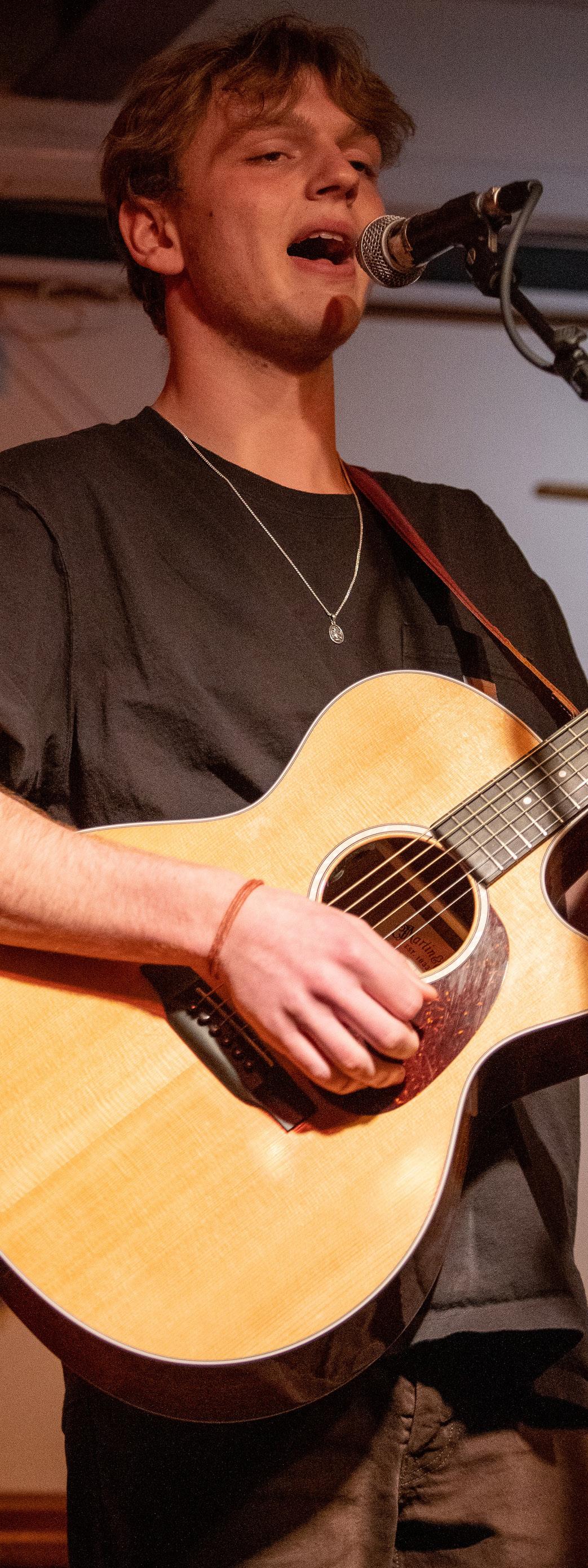 Rylee Bapst performs at Donkey Coffee in Athens, Ohio on March 24, 2022.
Rylee Bapst performs at Donkey Coffee in Athens, Ohio on March 24, 2022.

From ghost stories to actual sightings, it seems like the campus still has hints of the paranormal engraved in its bricks.BY CAROLINE GILLEN | PHOTOS BY DYLAN BENEDICT | DESIGN BY DREW FOLLMER
The students whisper among themselves while pointing at the large insane asylum on top of the hill overlooking Ohio University’s campus. The boarded up windows keep curious students away from the stain that still lingers on the floor, but these characteristics call attention to the building’s history. The stories from The Ridges are passed along through generations, each story taking a life of its own.
Despite the eerie nature of the building’s presence, OU students still form connections through hearing about the rumors of the past.
Mya Smith, a sophomore at OU studying pre-law, has heard her fair share of paranormal stories when she was growing up in the Athens area.
“I’ve heard about how Athens has five cemeteries that are shaped like a pentagram and in the middle, there is a dorm where a student had passed away in,” Smith says.
Hannah Beckman, an OU sophomore studying communication science and disorder, heard a similar story.
“Someone told me that there is a boarded-off dorm room in Wilson Hall because a couple of really strange things have happened there,” Beckman says. Both Smith and Beckman are strong believers in the paranormal.
“I personally do believe ghosts exist,” Smith says. “Whether it is because of unfulfilled souls who haven’t moved onto whatever comes next, or the souls of those were wronged and want revenge.”
Beckman’s belief comes from a paranormal experience she had as a child.
“I live in a house out in the country and when I was about four years old, I started seeing this figure at the end of my bed. I couldn’t make anything out besides the white of its eyes and the white of its teeth,” Beckman says. “Every time this happened, I would sprint to my parents’ room.”
Beckman never thought too much about what happened with the glowing figure until her parents got spooked by something. To this day, they never told her what it was.
“My mom called a family friend who was a medium to come and talk to me. She said she got in contact with a little boy’s spirit and afterwards she cleansed the house,” Beckman says. “I never saw the boy again after that. I think he just wanted to play but I hadn’t understood that at the time.”
Of the many ghost stories that travel around the campus, stories about The Ridges are the most popular.
“In high school, I watched a documentary on The Ridges and why it’s haunted,” Smith says. “Supposedly,
there is a woman who haunts one of the wings in particular and there is a blood stain left on the floor that they can’t get rid of.”
Beckman also heard stories about the asylum and the deaths that took place there.
“I heard that a bunch of people died there through unethical procedures,” Beckman says. “But honestly, I believe a place like Athens that has so much history is certainly bound to have some active spiritual areas.”
According to Ghosthunting Ohio, a book written by John B. Kachuba, an OU alumnus and professor, modern psychic researchers believe that Athens is a portal between our world and the spirit world. The portal allows spirits to easily travel between worlds.
One night, Athens resident John Koons supposedly crossed paths with a spirit who informed him all eight of his children would be gifted mediums. Koons embraced this concept and built a small room on top of Mount Neb, the highest peak in the region. There, in the small room, the Koons family would perform seances.
The Koons Family Spirit Room is considered to be a big reason why the paranormal seems to attach itself to Athens.
The Director of Development and Outreach at the Southeast Ohio History Center, Tom O’Grady, has
a different viewpoint on Athens’ paranormal activity.
“Back when I was a grad student in the early 1980s, I lived as a volunteer on the third floor of the asylum,” O’Grady says. “I’ve been through all the buildings, the basements and the attics. I didn’t hear the place was haunted until the early 2000s. I never saw a ghost but maybe I just wasn’t looking hard enough.”
O’Grady believes the hauntings to be a social phenomenon and recreational attraction relegated to the 21st century. “The stories of the hauntings all started up about 20 years ago but none of them have any basis in fact,” O’Grady says. “The hauntings appear to be a marketing strategy and is growing each year. People seem to love it.”
O’Grady says that people today look back at procedures like hydrotherapy, straitjackets and lobotomies as dark ages of mental health treatment, but at the time they were considered state of the art. So, what seem like horrible and torturous methods of healing today were not seen as a horrifying issue at the time. It does not necessarily make sense to assume the hauntings have anything to do with the procedures of the time period.
However, any disbelief does not stop the paranormal rumors from spreading around campus and throughout the

community. One of the most wellknown stories from the asylum is that of the woman and the stain, as previously mentioned by Smith. Margaret Schilling disappeared in December 1978 and her body was not discovered in the asylum until mid-January 1979, according to The Preservation Works website.
“Margaret Schilling died under unusual circumstances at the asylum,”
“I believe a place like Athens that has so much history is certainly bound to have some active spiritual areas.”
O’Grady says. “The room she died in was normally not accessible. She apparently got into that room because there were construction workers in there. She must have snuck in at some point and hid in there until they left. When she didn’t show up for dinner employees searched the building and grounds for her. It was a typical protocol.”
O’Grady shares that the staff contacted law enforcement right when she didn’t turn up. After a failed intensive search, they eventually had to give up.
“It was thought she may have left the grounds. She wouldn’t be the first person to ever leave the facility. They probably assumed she would show up eventually, or they might find her at home,” O’Grady says. “Workers went back to their lives and then two to three months later some people started to notice a foul odor. They eventually tracked her down. She was laying naked on the concrete floor with her arms crossed over her chest.”
According to the reports, at some point Schilling must have removed all her clothing and folded it up on the windowsill and then lied down on the
concrete floor. Later on, it is said that she must have gotten hypothermia and died from heart failure.
“It appears that Margaret could have, at any point, decided she was done with this business and being hungry or wanting to sleep in a bed [and] could have gotten help,” O’Grady says, “There were a lot of things in the room which she could have used to break a window. There were always people wandering around outside the building so she could have called out and someone would have heard her. It doesn’t appear that she never sought any attention. It may have been her decision.”
The most haunting part is that most people don’t even know her name; Schilling has been dwindled down to nothing but a scary story about a disconcerting stain.
O’Grady shares that the stain was most likely caused by a combination of the sun passing by the south-facing window every day and the organic fluids from the decomposition of the body. Those around town who know anything about The Ridges seem to know two things: it is haunted and there is a stain. O’Grady believes there is a more important lesson to be taken from Schilling’s story.
“Margaret’s death is an example of the dark depths that the human mind can take a person and it’s tragic to me that, as a university and a community, we have done nothing to restore Margaret’s humanity to her. She is known across the country as a stain,” O’Grady says.
Oftentimes rumors are far from the truth, leading stories to take lives of their own. It’s still a debate between the residents of Athens if ghosts really do roam the streets of the historical town. Some people say the spirits of patients are stuck in a limbo roaming the halls of The Ridges and others say the ghosts are nothing but stories.
“I think about the nurses who work up there and the doctors and thenclients who lived there — the builders of that amazing asylum, and the groundskeepers and kitchen workers and those that worked the farm,” O’Grady says. “If you close your eyes, you can see them, right? Those are the real ghosts of the Athens Asylum.” b
True crime has seen rapid growth over the years and has changed the way people, especially women, interact with the subculture.
BY CAROLINE BISSONNETTE DESIGN BY JULIA GREENWOOD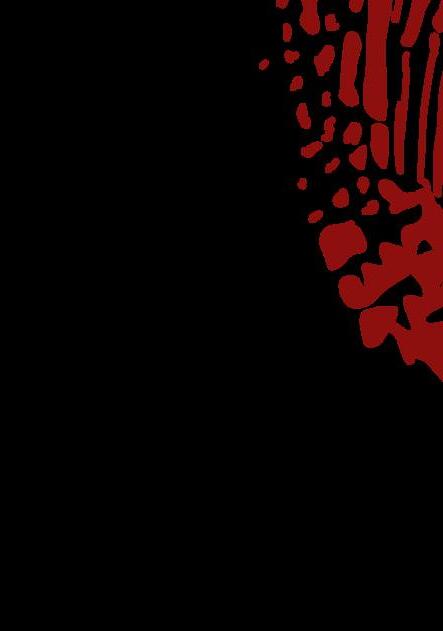
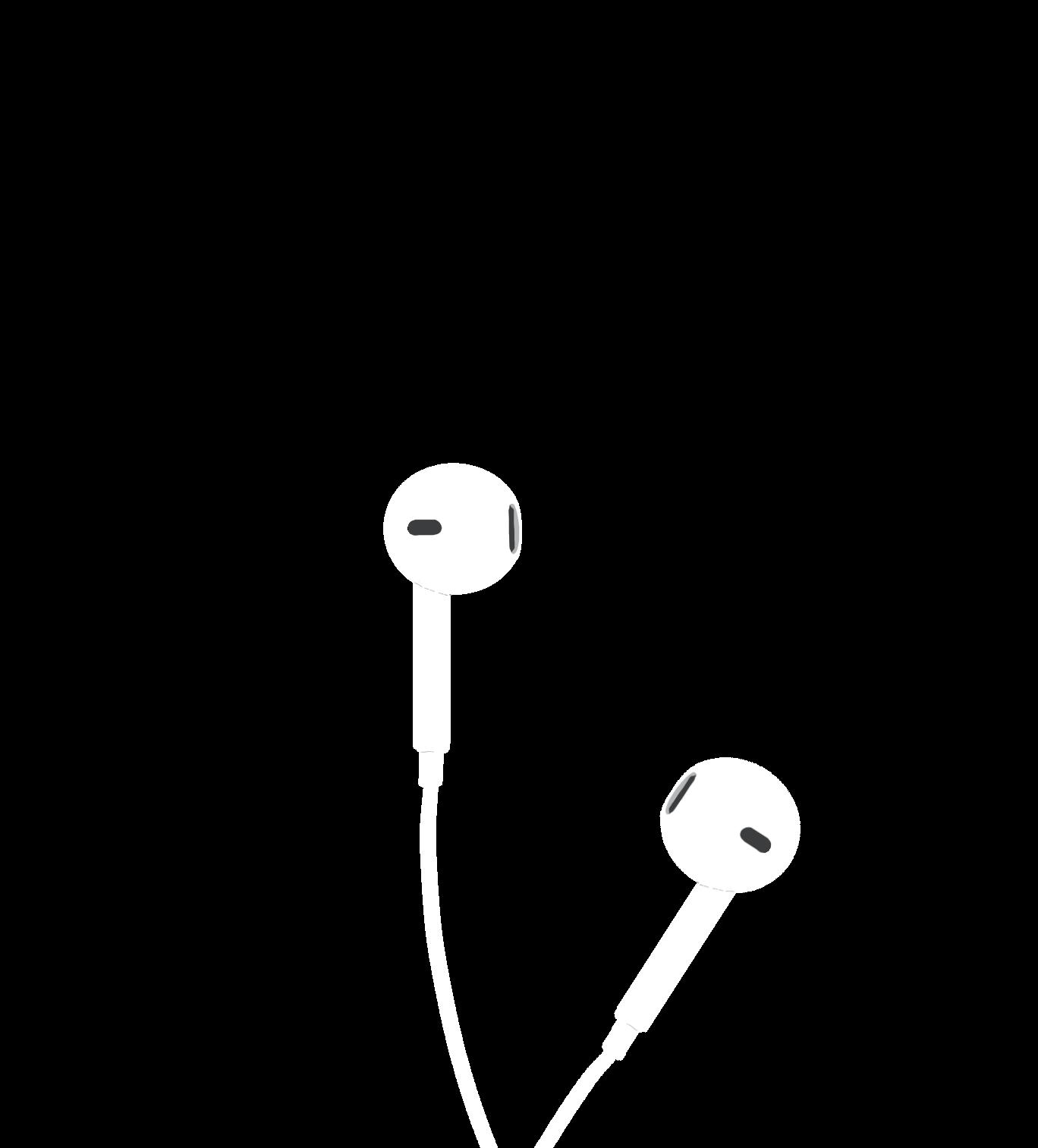
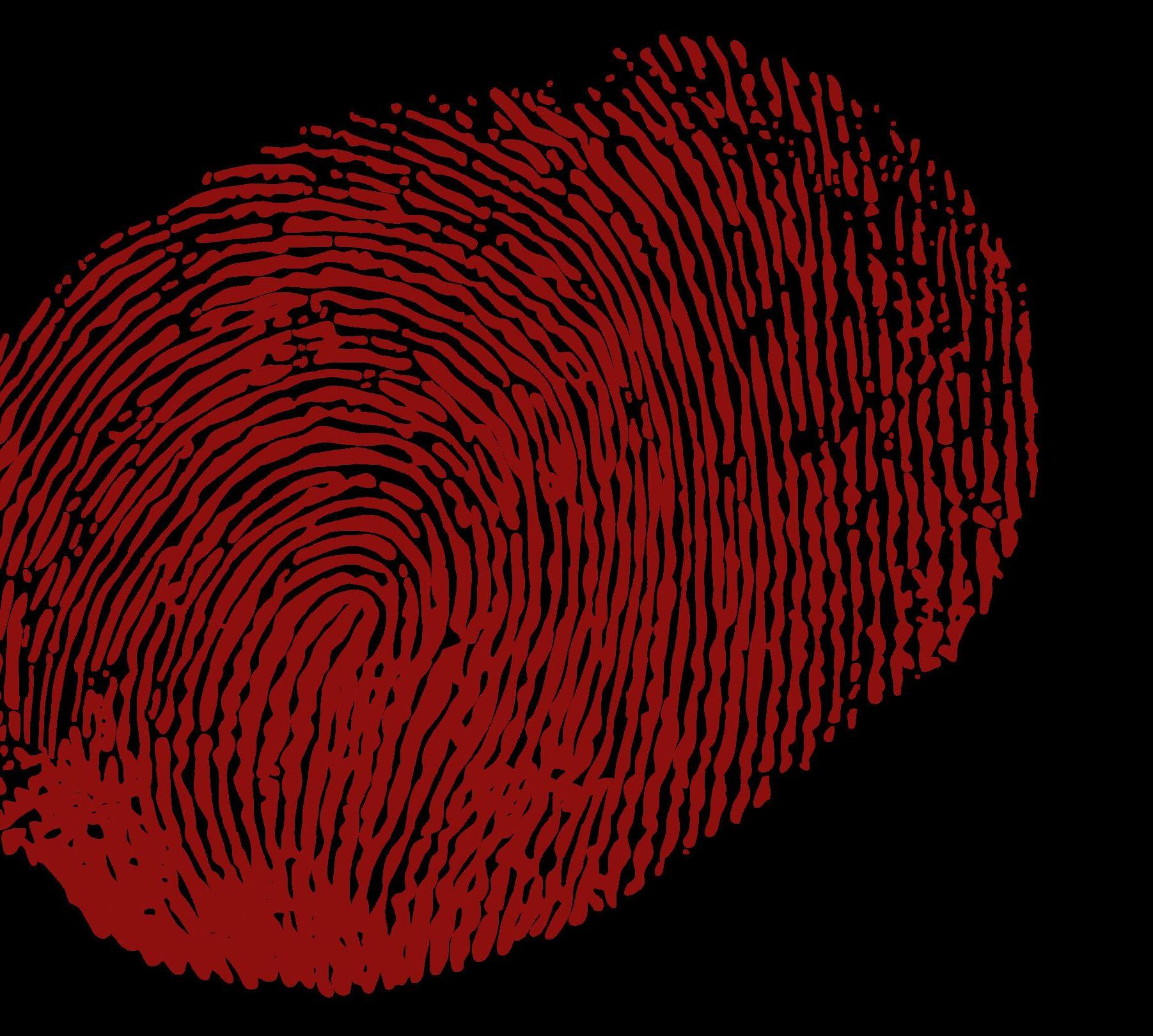


woman feeling her way through the brisk night air. She constantly checks her surroundings, so as to not miss any lurking danger. She approaches the safety of her home but contemplates lengthening her journey to finish the last five minutes of the true crime podcast playing in her ears.
up about 85 percent of the podcast’s listeners. In fact, women make up an overwhelming majority of true crime content consumers. Whether they are reading, watching or listening, women are a big reason that true crime media gets so much attention.
This hypothetical young woman is not alone. As addictive as it is enticing, true crime has infiltrated the everyday lives of people everywhere, but what makes it so irresistible?
Although true crime-related media has been around for much longer, a burst of excitement around the content has appeared to surface in the last decade or so. The number of content creators greatly increased as social media apps flourish, in addition to the involvement of streaming services like Netflix. With the almost inescapable increase of content, the number of true crime consumers naturally saw a large increase as well.
Molly Wilson, a sophomore studying journalism at Ohio University, likes to consume true crime-related media. More specifically, Wilson is a regular listener of “Crime Junkie,”one of the internet’s most popular podcasts with more than 500 million downloads since its debut in 2017, according to their website.
The two women who host “Crime Junkie” focus on telling the stories of crimes with the intention of keeping their audience on the edge of their seats. The hosts are longtime true crime consumers who found success in creating a true crime podcast themselves. The truth and tension of the stories they tell keeps the audience entertained and attracts listeners who crave suspense.
“I think that what intrigues me the most [about true crime] is that this is something that actually happened,” Wilson says. “And also thinking about how we can keep it from happening again.”
Despite “Crime Junkie” being available to everyone, a survey done by Media Monitors found that women make

One popular podcast series titled “Mared and Karen: The WVU Coed Murders,” focuses on two college-aged women at West Virginia University who were said to be hitchhiking back to their dorm in 1970. They were never seen alive again. The podcast episodes discuss the murder, as the creators give the details of the story in hopes of discovering who really committed the crime. Despite Eugene Paul Clawson being convicted of the crime, podcast host and author Geoff Fuller did not believe that the professionals caught the right person.
Fuller dedicated much of his life to studying this case, hoping to come to a conclusion that he found more believable. Eventually, he did. He partnered up with Sarah McLaughlin, who also had an interest in the case.
Along with writing a book about it titled The WVU Coed Murders: Who Killed Mared and Karen?, the two joined forces with Kendall Perkinson as their narrator and co-creator, and the three launched the podcast for Mared and Karen that many listeners have grown to love.
“Today’s true crime audiences want to both hear about a mystery and get involved in solving it,” Fuller says. “It helped that while I believed we’d found the perpetrator, Sarah was unconvinced. I think it was Kendall who first pushed us to lean into that difference of opinion, and both the podcast and the book are the better for it.”
The difference in opinion between the two hosts as to who is truly guilty for the crime allowed for further conversation about the case. Listeners were able to soak up the information and draw conclusions for themselves, possibly different from Fuller and McLaughlin. This level of mystery is often what true crime-subscribers want to hear.
Like other true crime podcasts, the listeners of Fuller, McLaughlin and Perkinson’s podcast, which is now titled “Appalachian Mysteria,” are mostly female. Younger female
audiences likely appreciate not only the group’s storytelling, but the information and signs that come with learning about a murder and are more useful in their everyday lives.
One reason why women have adopted a special interest in true crime over men is the fact that women are more likely to become victims of crimes that are the focus of many podcast episodes, according to McLaughlin.
According to the National Coalition Against Domestic Violence, more violent crimes are committed against women than men. More specifically, these crimes occur more often against female-presenting people. This means that true crime stories are more likely to be centered around the killing or disappearance of a woman than a man.
Sarah Horvath, a graduate student in OU’s Department of Psychology, brings a more professional point of view to the issues that come with the hype around serial killers.
“For some individuals, receiving attention for their crimes might act as a form of reinforcement for these behaviors,” Horvath says. “Reinforcing behaviors only serves to encourage that behavior.”
“I think women — and obviously I’m generalizing here because the reasons a specific woman or man would be fascinated by true crime are their own, not determined by gender — women are empathizing with the victims and looking for clues about what to be wary of, what behaviors to halt or avoid in others [mostly men] and how to stay safe,”
“I’ve been put on hold at my [gynecologist’s] office and instead of the usual awful ‘muzak’, they play a list of tips for avoiding sexual assault,” McLaughlin says. “I would bet money that the urologist’s office sticks to the standard hold music. I don’t think it’s in the back of men’s minds as often as it is for us.”
Because there is such an overwhelming majority of true crime podcast listeners being female, there are certainly multiple reasons why this is the case. Fuller has a slightly different take on the matter.
An issue that may arise from a woman’s innate will to empathize is the risk of empathizing with the wrong person. With the rise of the true crime phenomenon, the community has also seen problems with the audience glorifying murderers and criminals. This takes the attention away from the victims and urges social media users to post about the killer rather than the victim.
A popular and recognizable example of these situations is what the internet has done with Ted Bundy. Netflix is partially to blame because of their use of teenage heartthrob Zac Efron portraying Ted Bundy in a 2019 movie about his serial killing. This is not to say that Netflix is the reason people think Ted Bundy is attractive, but this arguably did not help in halting the discussion.
“It’s definitely a fine line because it is hard to tell a story about a murderer without talking about the murderer,” Wilson says. “But one of the reasons I like ‘Crime Junkies’ is because it definitely has a victim-centric point of view.”
The idea of glorifying serial killers is a relatively well-known phenomenon. With the addition and widespread popularity of TikTok in the media scene, true crime fans have been able to create and watch short videos relating

“True crime definitely affects mental health,” Perkinson says. “And I sometimes wonder how much fear and mistrust of strangers it’s engendering in audiences that consume it often.”
Where it is arguably important to raise awareness, this obsession with true crime may be too strongly infiltrating the minds of young women. However, this can be and likely is seen as a good thing by people in many situations.
In 2021, a young woman named Gabby Petito went missing after going on a cross-country trip with her fiancé. Before long, the internet got involved and the case became widely known.
After the case started gaining traction online, thousands of women and other users interacted with TikTok videos about Petito’s disappearance saying they were creating a folder full of self-identification information, such as fingerprints, photos and other information. In September 2021, Petito was confirmed dead and in January her fiancé admitted to murdering her in his own suicide note.
All in all, TikTok has been a useful tool in aiding with the growth and awareness of the true crime subculture.


— besides actually solving it. As long as the true crime community can include massive audiences, young women will continue to take the long way home to hear the last five minutes of a true crime podcast. b
Southeast Ohio schools make efforts to provide a holistic approach to preparing students for both college and the workforce.
BY JOSIE DONOHUE | PHOTOS BY AZIZ AL FADHA | DESIGN BY RACHEL RECTORLack of resources in rural southeast Ohio school districts leaves education systems wishing they could provide more support to their students. Students from the area tend to struggle more in their journeys from becoming high school graduates to college students or employees.
Meigs and Logan high schools challenge the status quo and provide an abundance of opportunities for their students to succeed after graduation. Here’s what the professionals have to say about resource allocation in southeast Ohio high schools.
Tiffany Arnold, an assistant professor of instruction at Ohio University, spent more than 15 years working with federal TRIO programs, which provide support for low-income and first-generation college students. As a graduate student, she conducted studies and wrote her graduate dissertation about barriers that Appalachian students face.
Arnold says, economically, the people who earn a college degree are more likely to leave their rural hometowns to find jobs that complement their majors of study or to make more money. However, those who choose to have degrees and stay within their community face a different reality.
“It’s really alienating for the people who left and want to come back because they don’t feel welcome there. They don’t feel like there’s anything in the town for them anymore,” Arnold says.
Brain drain is a phenomenon in which the “best and the brightest” move away from a community for better financial and social opportunities. A 2019 study from the Economic Development Quarterly defined it as: “Put in a broad perspective, brain drain is an occurrence in which talented or skilled individuals leave a region due to limited educational opportunities, lack of job prospects or economic instability and other factors.”
Appalachia spans 13 states in the U.S., so it would be difficult to generalize all of Appalachia as having a single shared experience due to regional differences. Therefore, all southeast Ohio schools do not share the same educational experiences, according to Arnold.
Abby Harris, a guidance counselor at Meigs High School, says the school strives to provide options for whatever pathway students choose after graduation, which includes college, the workforce or the military.
Meigs High School hosts not just college fairs, but also career fairs, and brings in military recruiters so students feel they are not limited, according to Harris. It also hosts signing days for students entering trades and the military, so signing is not limited to just incoming collegiate student athletes. That is done to provide an inclusive environment for all students in making their post-graduation decisions.
About 45 miles away, Michele Schein says Logan High School also provides opportunities for students to explore all possible pathways after graduation. Schein is one of the three counselors at Logan High School.
Logan High School offers career and technical programs for students through Tri-County Career Center. Students who take vocational classes at TriCounty then create capstone projects during their senior year, which prepares them for careers after graduation, according to Schein.
When comparing the resources high school students in southeast Ohio have, Arnold says it is dependent on what school district a student lives in.
“There is some social stratification [and] there are differences in socio-economic status that others may not realize,” Arnold says.
In a study published in 2019 by the Journal of Career Assessment, a team conducted research to see what barriers high school students have in rural Appalachia. Some of those barriers include regional

issues such as infrastructure barriers and lack of work opportunities or physical health issues, such as higher rates of depression.
“I think college is a wonderful opportunity for many people but it’s not for everyone. I will always be an advocate for trade schools.”
ABBY HARRIS GUIDANCE COUNSELOR AT MEIGS HIGH SCHOOL
In terms of career and college preparatory measures, students face barriers such as living in low-income areas, having less access to diverse career choices and career role models in the community and lack of academic preparation.
The research team for this study, led by faculty at the University of Tennessee, found the issue comes from a lack of resources and the students’ lack knowledge about postsecondary education and career options. Students in rural areas who do not obtain all the information they need to succeed will either think they can figure college out on their own or they go straight into the workforce.
“I think college is a wonderful opportunity for many people but it’s not for everyone,” Harris says.
“It’s not the only pathway to have in your career and make a living. I will always be an advocate for trade schools.”
Students from the area who may not have resources such as College Credit Plus classes, Advanced
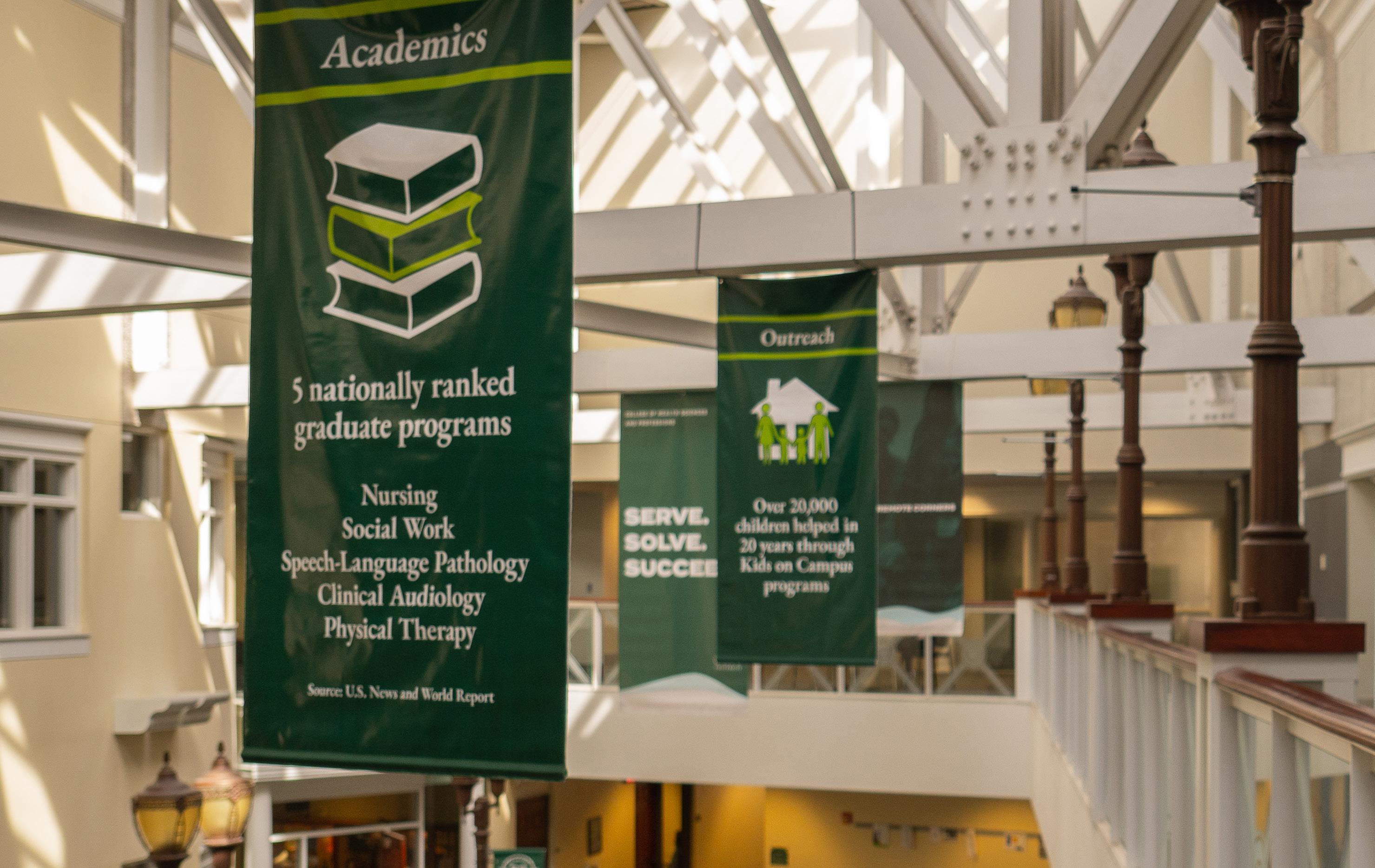
Placement (AP) classes, or a variety of course options typically end up struggling with independence and study skills in college, according to Arnold.
“Just because of a lack of resources, which all schools in southeast Ohio have, and all schools in the Appalachian region are faced with, schools may struggle to prepare students for college,” Arnold says.
Gracie Walburn, a junior studying middle childhood education, math and language arts, graduated in 2019 from Jackson High School, which is 40 miles from OU’s Athens campus.
Walburn says Jackson High School did a good job of providing resources to students such as offering a college success class, AP classes and a free ACT waiver for all students. However, she wishes she would have received more guidance adjusting to college such as educating students about how to navigate freshman year.
“[OU has] this really huge orientation [with] thousands of people,” Walburn says. “It’s just overwhelming.”
She says freshman orientation was a stressful experience and wishes she would have learned some of that information in high school before starting college.
“If I would have heard it from people that I trusted from a small town before I came, I think it would have resonated more,” Walburn says.
From 2013 to 2017, the Appalachian average
college completion rate was 23.7 percent, while the U.S. average was 30.9 percent, according to the Appalachian Regional Commission.
In a typical senior class at Logan High School, about 65 percent of students attend either a four-year college or two-year college and about 35 percent go into the workforce or the military, Schein estimates.
In a typical graduating class at Meigs High School, about 30 percent of students go to a four-year college, 20 to 25 percent of students attend a trade school or community college and about 50 percent go straight into careers or the military, Harris estimates.
“From the outside, there’s a perception that we prioritize college more, but I think it’s just the culture today,” Harris says. “I think it’s turning around, and people are realizing that we need people in trades. I think we do a good job here at Meigs High School to focus on careers, and it’s not just [about] college.”
Meigs High School takes part in a program called “Meigs County Career Compass,” which connects all three high schools within Meigs County with local businesses. In the MC3 program, students can participate in internships, pre-apprenticeships and job shadows with local businesses such as Farmer’s Bank, Front Paige Outfitters and Mark Porter Chevrolet Buick GMC in Pomeroy.
Although Logan High School finds a balance between providing resources for students in the
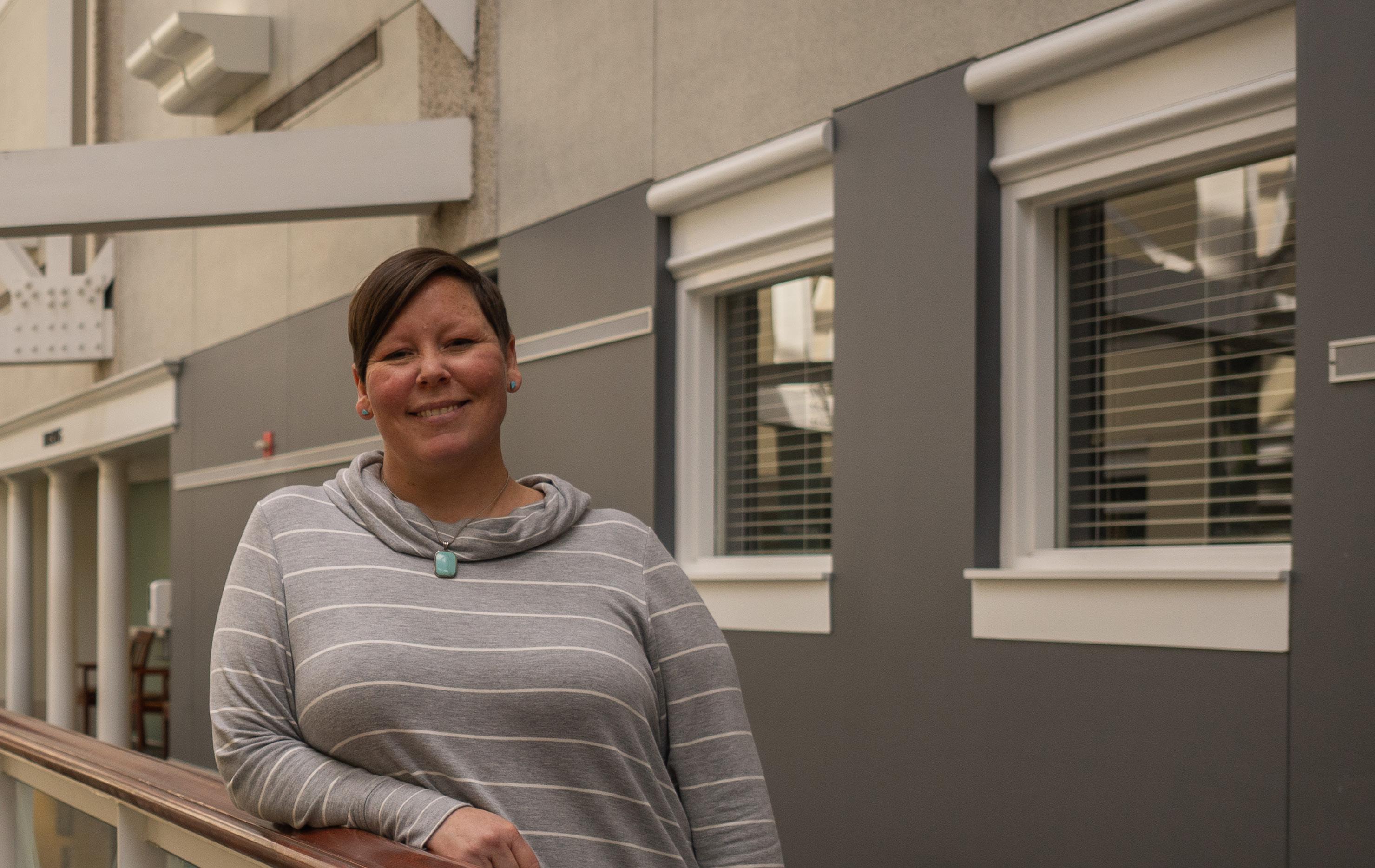
post-graduation career journey, Schein notes they have recently put a stronger emphasis on emotional counseling by eliminating the term “guidance counselor” and replacing it with “school counselor.”
“Now we have evolved from a focus on postgraduation planning to creating and maintaining comprehensive school counseling programs,” Schein says. “Most of our day is spent addressing emotional support, family issues, social development, academic guidance and college and career planning.”
Both Harris and Schein say if they could do anything else, they would like to spend more time individually with each student to be able to form stronger relationships and provide more personalized guidance.
The benefits of counseling have been known for decades. Sarah J. Snider, an assistant professor at the University of Tennessee in 1979 found that if schools allowed a relationship to form between a student and a teacher, then the student would realize their unique Appalachian heritage, which could then help them better socialize within and outside the rural landscape.
This acceptance, both personally and with an educator, could allow rural students to have mutual respect for themselves and others, according to Snider.
High schools in the area strive to provide a holistic educational experience and provide various employment opportunities to students throughout
their career. The lack of funds in the area means schools may not be able to support students economically, but the schools can provide emotional and social support throughout their high school career and beyond.
When asked if she had any advice for southeast Ohio schools, Arnold says schools should try to implement education about the history of Appalachia. She says there is value in knowing about the region and living in it.
“If you’re looking holistically at personal development and student development, schools need to incorporate more education about Appalachia’s history,” Arnold says. “When you know about [the history], it really instills a positive identity with being Appalachian that you’re not getting anywhere else.” Walburn hopes to return to Jackson to teach fourth or fifth graders after she graduates and wants to help prepare them for their futures, even at a young age.
“I hope [by] being a teacher that I can instill that in them from a young age,” Walburn says. “If you don’t want to go to college, you can learn a trade or whatever works best for you, but don’t sell yourself short. I’m proud to be from southeast Ohio. So, I think becoming a teacher here, I’ll get the opportunity to share that.”b
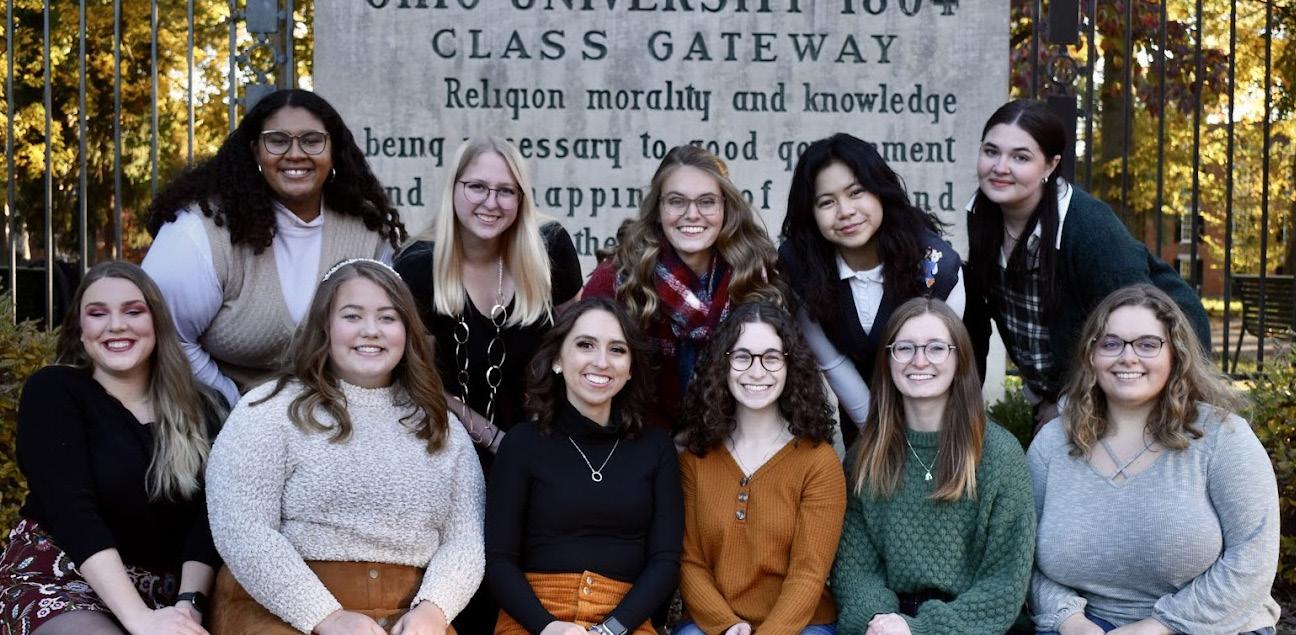
High-achieving students at OU sacrifice self-care in order to be productive.
BY HELEN WIDMAN | PHOTOS BY MAYA MEADE AND BEN SIEGEL | DESIGN BY KATE RECTORProductivity as a concept means something different for everyone. One person’s idea of productivity might be completing a 9-to-5 workday, cooking dinner and running errands until it’s time to do it all over again the next day. Another person’s idea of productivity might be exercising, taking a shower and completing a list of daily tasks they have. Sometimes productivity may even mean just getting out of bed one day.
For Mo Bailey, a junior at Ohio University studying psychology with a pre-med track and biology minor, productivity is how she contributes to the different organizations she is a part of. This includes being an Office of Multicultural Success and Retention (OMSAR) Scholar, working in the Women’s Center, being an underclassmen representative for the Minority Association of Pre-Health Students (MAPS), being a LINKS Peer Mentor and occasionally conducting lab research.
Bailey has found that studying in the science, technology, engineering and mathematics (STEM) field has made it difficult for her to engage in self-care activities outside of her academic and volunteer work due to the constant pressure to be productive and busy.
“Because of the work that people want to do and the culture that surrounds STEM, it’s very much a grind culture,” Bailey says. “And not only will your professors and professional people hold you accountable for the productivity that you produce, it’s also your peers. You’re not allowed to relax. It’s very competitive.
The culture within STEM is competitive enough for everyone to want to be productive where it’s very, very toxic.”
The ongoing coronavirus pandemic has shifted the way that certain work cultures operate and how students like Bailey currently view the idea of productivity.
“I would say that productivity is now enforced even in our homes because we don’t have the luxury of saying that we’re at home or we can’t do work because now we can work from home or do virtual work. So it’s almost like work has infringed upon our own private areas, which I’m not a fan of,” Bailey says.
One Forbes article offers the perspective that, “With performance management still trying to catch up to remote work, for those who do start to return to the office, there are still ingrained perceptions that a body in the chair for long hours means someone is busy and adding value — when, in fact, the opposite could be true.”
In other words, working all day does not always equal a productive workday, especially when that work infiltrates personal lives, which can limit rest time as a result.
Kylie Duncan, a junior at OU who is studying social work, is also treasurer for the Ambassadors to Survivor Advocacy Program (SAP), involved in Title IX acapella group and Bella Voce ensemble as well as a campus employee and OMSAR scholar. She is also a mother to a six-year-old son.
Duncan finds that balancing her academic work and extracurriculars to be quite difficult and that the pandemic
has added even more stress to her schedule. For Duncan, the shift in going from online classes back to in-person classes and meetings has been overwhelming amidst the ever-changing health protocols.
“I found that a lot of professors are very strict in their ways and not understanding that we’re still in the pandemic. I think it’s been extremely stressful,” Duncan says.
A community-university program, Kids on Campus, provides children in rural areas with access to educational opportunities and more. Although Duncan has not utilized the program, it can be a helpful resource for those balancing parenthood and school.
Duncan’s fiancé watches their son during the hours that she is in class and works at night, which means her day does not end when she steps off campus.
“He just works and then [in the] evenings it’s typically just me that has to run and go everywhere,” Duncan says.
Besides the added responsibility of being a parent, Duncan also faces outside pressures academically as a full-time student.
“I am on a scholarship on campus, and so I constantly feel like I have to keep everything perfect at all times,” Duncan says. “And I have to keep a certain GPA at all times. I have to do so many credit hours and so many community service hours on top of everything and a lot of those things aren’t offered within my schedule. And so, it just really — it’s a lot of pressure.”
In addition to academic pressure to succeed, some students such as Bailey find that other outside pressures also exist.
“I think especially myself, being a Black woman in general, I know that I have to work 10 times harder than everyone else just to be taken seriously. So, I’m not the type of person who can you know, take a day off because it will reflect not only me, but everybody I represent in my entire community,” Bailey says.
Although students may feel like the idea of productivity is overwhelmingly present in all aspects of their lives, Bailey admires her peers for their work ethic and passion.
“I think productivity culture can be very positive when you’re around other people who are very passionate about what they’re doing because it gives you a lot of passion yourself and forces you to really look into the things that you want to do yourself,” Bailey says.
“And that’s something I’ve seen like even as a STEM major, although it’s very competitive and very toxic, there’s a lot of people and peers that I have that are doing amazing things and it makes me want to do amazing things and collaborate. I think if productivity culture is geared toward the right people, it can be a really great place to produce collaboration and innovation. But overall, I still think it can be quite negative,” she says.
On another more positive note, remote work has been beneficial for many adults already in the workforce.
Alison Moore, the Assistant Director of Peer Mentor Programs at OU, feels as though working from home has actually helped her become more productive and given her more time to prioritize her mental health. Moore is also a mother and has prior experience working from home.
“I think when I was younger, and I was starting out in higher [education] and I didn’t have any children, I really threw myself into my work,” Moore says. “I had worked from home previously, like many years prior, when I didn’t have kids and I
found that I did not have a good work life balance because the work was always there at my home.”
Now, Moore says that it is much easier for her to be productive in her work at home because she faces less distractions that come with working in an in-person office setting. She can take short breaks or run her household as needed all while getting her work done, although sometimes outside of the 9-to-5 workday.
Moore has noticed some positives among the technological shift that the pandemic has brought on in regard to productivity. One of these positives is higher student attendance in Peer Mentor events; however, higher attendance does not always equal higher presence.
“There [is] a difference between like being present on [Microsoft] Teams and actually being engaged in dialogue,” she says.
As for the future, though, Moore is hopeful that the next generation of students and individuals entering the workforce will begin to understand the importance of mental health coinciding with productivity.
“I see this with your generation is that you all are prioritizing mental health; you are able to have a better work life balance,” Moore says.
Bailey shares similar feelings and thinks that setting boundaries early on in a college career is crucial to maintaining an academic and mental health balance.
“My advice would simply be to make sure that you’re setting boundaries with people who expect things from you because in college you’re going to have a lot of people who expect a lot of stuff from you, especially if you’re going to be involved in certain organizations and things like that, but never forget that you come first and your mental health comes first,” Bailey says. “And setting boundaries with people who probably understand the things that you’re going through is not a bad thing, and it will help you overall.”b
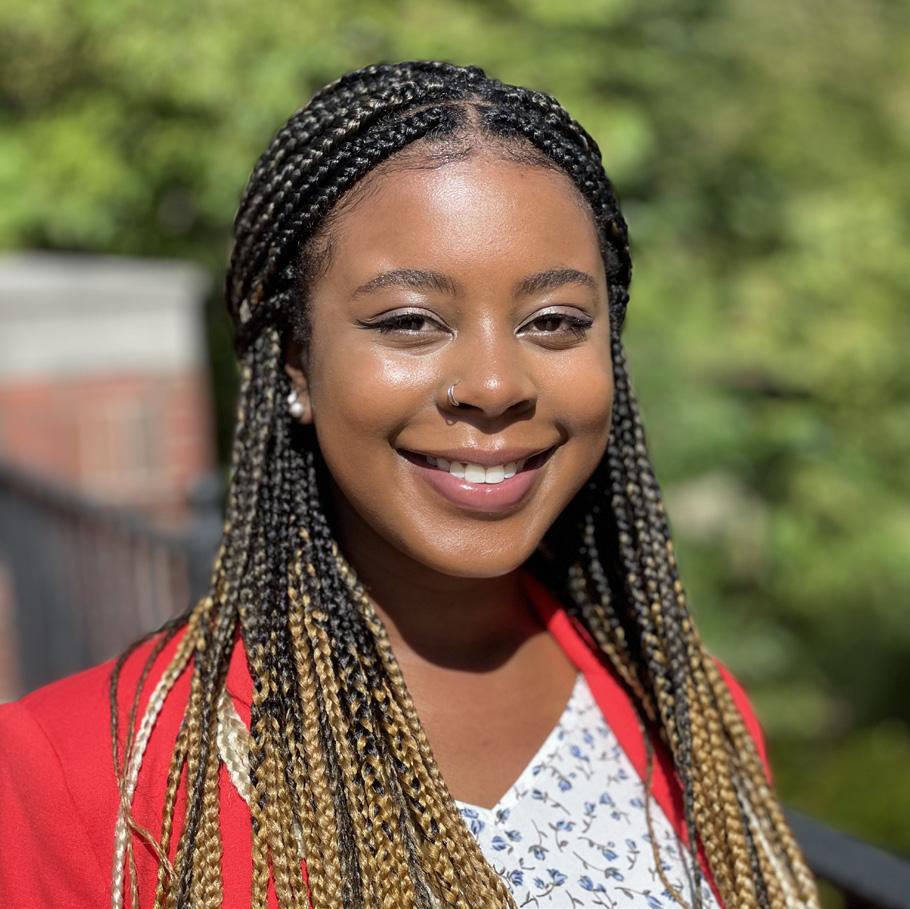
Our Outcomes initiative to bring awareness to Black health.
BY HELEN WIDMAN | PHOTOS BY PEARL SPURLOCK | DESIGN BY KATE RECTORWhen Dianna Johnson-Ward first told her mother that she wanted to work at a college, her mother said, “What are you going to do there?” All Johnson-Ward knew was that she wanted to work in health and education. Now, she has started an initiative to change the outcomes that Black women face in the realm of health every day.
She graduated from Ohio Northern University in 2016 with a bachelor’s degree in exercise physiology and went back to school in 2018 to pursue her master’s degree in public health at Northern Illinois University. She is currently a wellbeing support manager at Ohio University.
“... It was kind of serendipitous, maybe, that I ended up here,” Johnson-Ward says. “It wasn’t my original plan. But this kind of work, the job description, I was like, this is it.”
Using her newfound role as a wellbeing support manager, Johnson-Ward decided to dig up a project from her graduate school days: Change Our Outcomes. Originally, the social media project was geared toward increasing awareness of Black women and breast cancer.
According to Johnson, Black women are not typically the face of breast cancer awareness, and they don’t receive mammograms as much as other racial groups, despite being more genetically predisposed to it. The Breast Cancer Prevention Partners
website says that African American women, and young women in general, are more likely to present a triple negative subtype of breast cancer, which is also known to be more aggressive.
The Change Our Outcomes project had never fully come to light — until now.
“So, with working at a university, I was like, ‘This is the perfect age,’” Johnson-Ward says. “We’re building lifestyle habits to really mitigate some of that future predisposition that Black women already have to getting those … chronic diseases and having those negative outcomes.”
Re’Aija Grice is a junior at OU studying exercise physiology with a pre-med track. Johnson-Ward has become a mentor for Grice and other students.
“… Having another representative African American woman or just multicultural woman just in general is very impactful. I don’t think some people understand that,” Grice says.
Johnson-Ward’s supervisor, Ann Brandon, is the associate director for prevention and education and also admires Johnson-Ward.
“People just gravitate towards Diana … it’s almost like her energy embraces you and you feel part of something being around her,” Brandon says.
To Grice, this initiative is about more than just exercising.

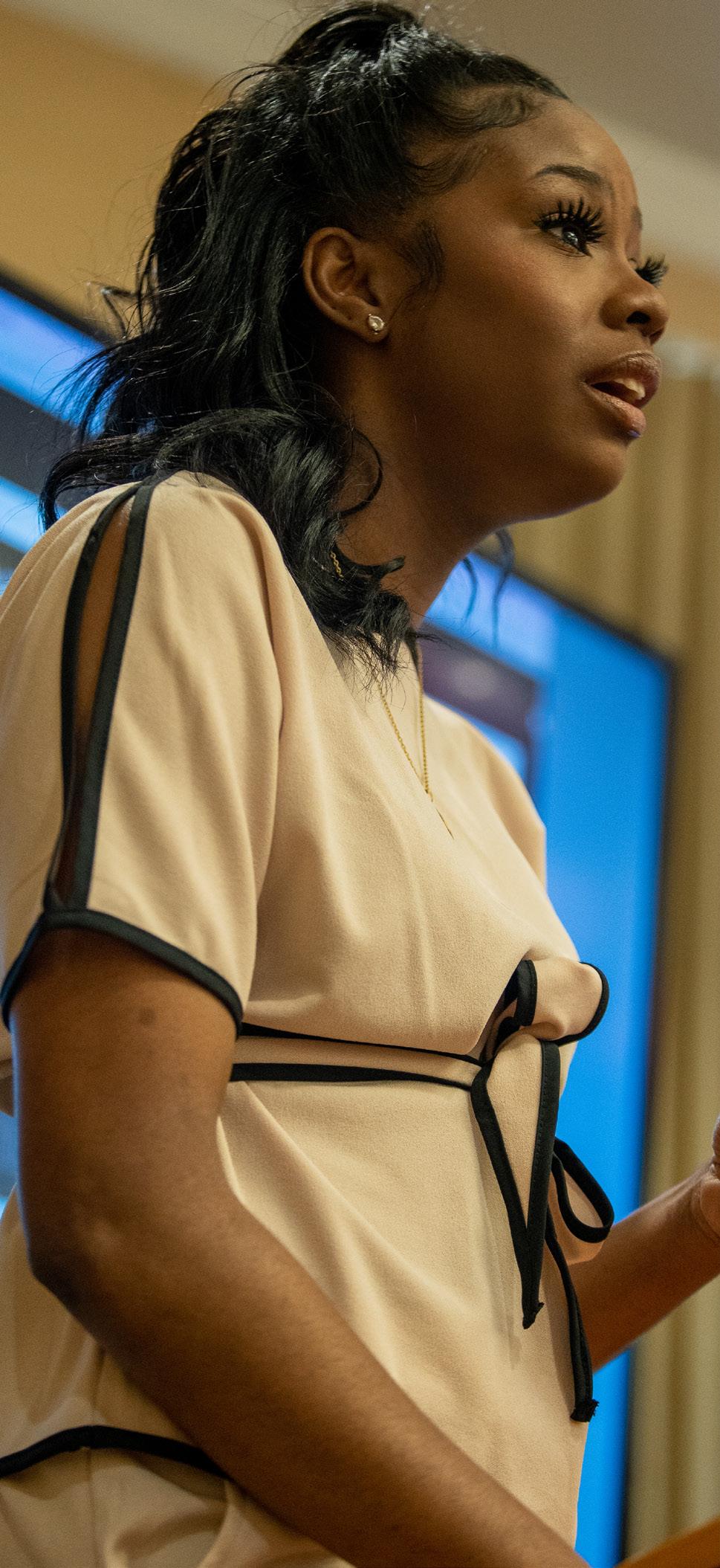
“I think Change Our Outcomes is much deeper than that. I think it also dives deeper into, ‘Can I even talk and have an honest conversation with my health care provider because they don’t look like me?’” Grice says. “And there’s a lot of … lack of trust within the healthcare field because of the lack of representation.”
According to a 2018 brief titled “Black Women’s Maternal Health: A Multifaceted Approach to Addressing Persistent and Dire Health Disparities” from the National Partnership for Women and Families, 22 percent of Black women report discrimination when receiving medical care at the doctor or clinic.
“There are certain things that systemically I go through as a Black woman, especially when talking about things like maternal and infant health, that a white physician might not totally understand,” Johnson-Ward says.
The brief also cites that “Black women experience higher rates of many preventable diseases and chronic health conditions including diabetes, hypertension and cardiovascular disease,” which is based off data from the Agency for Healthcare Research and Quality that stems from the U.S. Department of Health and Human Services.
Johnson-Ward’s modern version of Change Our Outcomes aims to bring awareness to the overall disparities Black women face with medical care and health-related issues.
“… Black women specifically get the least amount of physical activity, we live the most sedentary lifestyles, which are one of the key factors in getting things like cardiovascular disease and strokes and diabetes and obesity,” Johnson-Ward says.
Although Change Our Outcomes is branded by JohnsonWard, and will go wherever she goes outside of OU, Brandon emphasizes the importance of the initiative.
“I think it’s important for a space anywhere on earth,” Brandon says. “It should be in our communities because Black women, they’ve had to carry the burden and the barriers and the oppression as far as a marginalized group and underserved group in every facet: in education, in health care, in no access to healthy foods, and this goes back decades and decades …”
The organization had its first kick-off event in November 2021 with an awareness walk.
Group members go on walks and sometimes walk together. They also meet up for fitness classes, rock climbing and overall, aim to encourage fitness among the Black student community at OU. Johnson-Ward can be found at most of these events.
Johnson-Ward also hosts her own biweekly podcast called “Our Space,” where she discusses health-related topics and sometimes talks with Black medical or health-related professionals. JohnsonWard believes that some of the issues Black people face within the healthcare field may stem from how medical students are learning and what has been taught to them.
Check out Johnson-Ward's podcast called Our Space on Spotify. The podcast can also be streamed on Apple Podcasts and Listen Notes.

Ultimately, she hopes that Change Our Outcomes can continue to help OU students become more active and increase awareness about Black women and their health care, both physically and mentally.
“... We want to change our outcomes,” Johnson-Ward says. “We don’t want to continue dying at these high rates of maternal mortality and chronic disease and mental health.”b
Four Ohio University students share their internship experiences.
MAJOR: MEDIA ARTS AND STUDIES
INTERNSHIP: KEY TALENT MANAGEMENT, LOS ANGELES
Key Talent Management, or KTM, is a talent agency with locations in Los Angeles and New York City. KTM works with aspiring actors, directors, writers, musicians and influencers. DePiore was able to help the company’s clients find auditions that he and his supervisors felt would best fit their skill set.
“It was so ... important for me to see the business side [and] how the business actually operates, how people actually get connections and get jobs, and I think a talent agency is really good for that,” DePiore says. “It’s a really good starting point for learning the businessoriented aspect of the creative profession.”


YEAR: THIRD-YEAR SENIOR
MAJOR: JOURNALISM STRATEGIC COMMUNICATIONS
INTERNSHIP: MISS UNIVERSE ORGANIZATION
Blashinsky was selected as one of two OU students to intern with the Miss Universe Organization in New York City after her sophomore year. She was responsible for handling PR and social media.
“I was able to be a part of the 70th Miss Universe Competition,” Blashinsky says.
“We went to Eilat, Israel, and it was incredible. Another thing that I was really happy to be a part of [was] the 70th Miss Universe [which was] called the Green Miss Universe because [the organization is] trying to make it as sustainable as possible. [It] was really great to be ... a part of that community where we all have the same mindset.”
Many students enter college with passion and purpose; others enjoy exploring their interests before committing to just one option. Regardless of major or future career plans, many strive to land the perfect internship to refine their skills, impress future employers and discover new career opportunities. As these students approach graduation, employers are tasked with identifying what sets them apart and an impressive internship can be helpful in doing just that. Backdrop talked with a few Ohio University students who received internships that make their resumes shine.

YEAR: SENIOR
MAJOR: STRATEGIC COMMUNICATIONS MINOR: MARKETING, AND POLITICAL COMMUNICATION
INTERNSHIP: THE BORGEN PROJECT
The Borgen Project is a nonprofit organization that aims to eradicate global poverty through legislative affairs. The organization believes American leaders should make poverty a focal point of U.S. foreign policy.
“I started off as a PR and marketing intern for three or four months or so and ... then [I] came back during the summer to work a sixmonth internship with them and I got a promotion as a regional director,” Calvis says.” I was doing a lot of the PR marketing that I was doing with my initial internship, but as a regional director, I held more of a leadership position and [had] a lot of responsibilities when it came to lobbying my specific congressional leaders.”
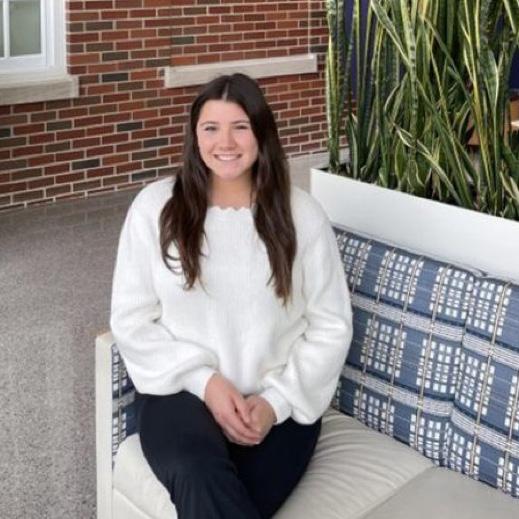
YEAR: JUNIOR
MAJOR: SPECIAL EDUCATION, MODERATE TO INTENSE
INTERNSHIP: TEACHING PLACEMENT AT GUIDING HAND SCHOOL, GRADES K-3
The Guiding Hand School offers special education programming for students from ages 6 to 21. Students learn academic concepts and life skills and participate in extracurricular activities like music, art and gym.
“I’ve gained a lot of knowledge [about] the social-emotional aspect [in teaching] because kids, in general, can’t really understand emotions, but these kids specifically have [a much] harder time,” Burchfield says. “[I have gained a lot by] seeing different ways to teach what the emotions mean and just how they can apply them in their everyday [lives].”
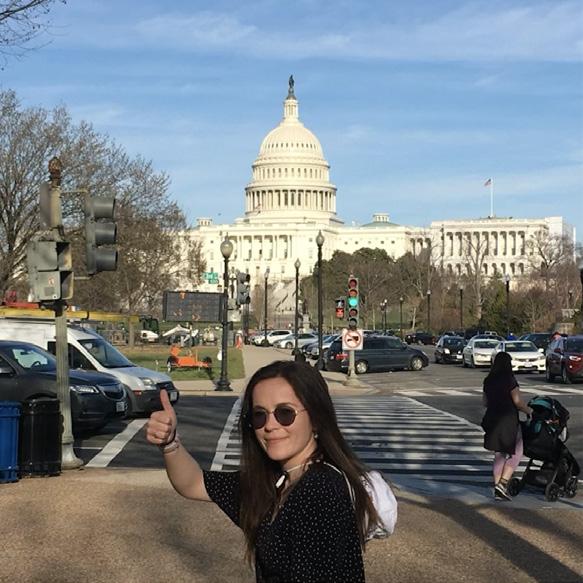
One Backdropper shares her top picks for summer reading and listening.
BY RORY BALL | PHOTO BY JACOB DURBIN | DESIGN BY RACHEL RECTORWFlights
hether you’re an avid reader or only have time to breeze through books in the summer, this list of books is sure to move and inspire.
by Olga TokarczukOriginally published in Polish, Flights weaves heartbreaking stories together to examine the importance of migration and travel in life. Chopin’s heart carries him home to Warsaw; a woman returns to her homeland to gain closure of a past loved one; a man succumbs to madness when his wife and young son go missing on vacation then suddenly return after months of investigation. The stories leave readers contemplating the significance of where strangers come from, where they have been and where they are going.
The
Alchemist by Paulo CoelhoFor those who need a refreshing, motivating read, The Alchemist teaches readers how to live in the present and follow their hearts. The story follows Santiago, a young shepherd boy, who yearns to travel and see the world after dreaming of treasures in a faraway land. Throughout his journey, Santiago is presented with omens and meets those who both help and hinder his journey.
The Last Black Unicorn by
Tiffany HaddishMy all-time favorite autobiography. Each anecdote from Haddish’s life is paired with a meaningful life lesson that almost any reader can relate to in one way or another. Haddish’s simple storytelling welcomes readers into the most intimate moments of her life that readers can empathize with and learn from.
Let the Great World Spin by
Colum McCannSet in Manhattan in the summer of 1974, Let the Great World Spin follows the lives of individuals watching a mysterious man walk on a tightrope suspended between the Twin Towers. The novel, comprised of fictitious characters, weaves together stories of loss and lament that reflect social issues of the 1970s in America.
The Five People You Meet in Heaven by Mitch Albom
A short, sentimental read that considers life after death. The novel follows Eddie, an amusement park ride mechanic who suddenly dies in an accident at the park, into his afterlife experience where he is greeted by the five people who impacted his life the most. The Five People You Meet in Heaven is a brilliant contemplation of how important varying relationships are in every person’s life. b
Not a reader? Here are 15 different songs to start your summer on the right note.

Use this QR code to check out the summer playlist on Spotify.
 Four of the five books on the summer reading list overlooking College Green on March 30, 2022.
Four of the five books on the summer reading list overlooking College Green on March 30, 2022.
These craftspeople demonstrate the lesser known art of lutherie — repairing instruments that have neck and sound boxes.
STORY & PHOTOS BY DYLAN BENEDICT | DESIGN BY RACHEL RECTORMusic can be a cathartic and personal experience for people everywhere, and this is especially true in Athens. Music is engrained in the city’s culture. Athens is home to Stewart-Macdonald, a massive distributer of luthier tools, do it yourself guitar kits and almost anything else you would need when it comes to working with stringed instruments. Over the years, this business has hired luthiers from all over the country and has created a community of people who are more passionate about music and lutherie than anything else. Some of the worlds most renowned luthiers live and work here, creating instruments for people all over the world and supporting the music scene around them through their life’s passion.

Erlewine is a luthier in Athens where he has made a name for himself by building and repairing guitars and making an extremely successful video series sharing his knowledge of lutherie. Erlewine moved to Athens in 1986 to work for Stewart-Macdonald (StewMac), a banjo manufacturer and seller. He was hired to bring them into the world of guitars.
“Moving to StewMac was big,” he says, “StewMac wouldn’t be where they are today without me. I’d be somewhere different [too], I wouldn’t be where I am without them.”
Before working for StewMac, Erlewine had made guitars for music legends Jerry Garcia and Albert King, but it wasn’t until his work with StewMac that he was able to cement his place in lutherie history. Now, he runs his own shop called Dan Erlewine’s Guitar Shop.

For the past 46 years, MacRostie has been sharpening his skills as a mandolin luthier, including some time working for StewMac with Dan Erlewine.
“From high school, through college, through the military, I have played guitar and worked on my own instruments out of necessity,” he says. MacRostie has been in Athens for the past 50 years, where he now works out of a barn from the 1800s that he has converted into his workshop. MacRostie runs Red Diamond Mandolins, his business where he meticulously hand-crafts his instruments.
On average, he makes between seven to eight mandolins a year, using this time to make sure each one is made with the proper care and attention. b
Kautz is generally new to the world of lutherie in Athens with only four years of experience. Kautz is an apprentice to Dan Erlewine and has been learning many of her skills from him. Kautz’s interest in lutherie first started in her family.
“I grew up around guitars and developed a love for them through my father,” she says. However, her experience has been difficult compared to many others.
“I have dealt with many issues being a woman in this industry,” she says. It has been a major issue during her time being a luthier. “There have been instances where I have been sexually harassed and treated poorly. You aren't taken seriously, ever. It's infuriating at times.”
Despite all the sexism she faces, Kautz pushes through to achieve her goals and prove she can work just as well as any other luthier.

Content warning and disclaimer: This story includes transphobic and misogynistic comments from Facebook, of which certain users will remain anonymous for safety reasons.
Journalism is not an easy passion to have. Being a journalist can be all-consuming and exhausting, but sometimes, that is part of the fun.
Throughout the five years I have been involved with journalism, I have learned, explored and pushed myself. I am learning the universals of the profession, such as the experiences most journalists have, through my involvement with publications at Ohio University. But there are certain experiences some journalists don’t face this early in their careers.
I am a young woman with an unrelenting motivation to achieve my goals. This is “intimidating” to some people, such as older men, who were often taught growing up that women should not act passionately by our patriarchal culture. There is more depth to the idea I mentioned and I will touch on its complexity later.
My interactions with men who have ideas of how women should act speak for themselves, however. During my senior year of high school, I was our magazine’s editor-in-chief. We produced an issue dedicated to social justice in 2020. I wrote a letter from the editor detailing the contents of the issue and why, given our country’s problematic origins, it was an important read. A takeaway from my letter is the following quote:
“This issue was written with the goal to feature those who have stories to tell about their experiences facing racism, homophobia, microaggressions and other forms of discrimination. If this issue is uncomfortable to read at times, that’s a reason to continue reading and reflecting.”
A month after we released the social justice issue, my letter was posted on a Facebook group dedicated to
“informing people” of happenings in my hometown of Powell, Ohio. A person was angry about what I wrote because some people believe that critical race theory is being taught in public K-12 schools. I ignored it and the comments because I didn’t feel it was beneficial to my growth as a writer and student.
Around the same time, I noticed a new “community” Facebook group emerged. This one was committed to criticizing teachers in my former school district for being “socialist indoctrinators.” I defended a teacher in the comment section of the post and said I felt threatened by the group. My comment was deleted but I took my comment to another post and published it there.
My second comment caught the attention of the creator of the group who posted my letter and in response to my writing said: “All can agree that Christy would have benefited from more instruction in English composition and less indoctrination in social activism. A one sentence paragraph? C’mon, man!”
I was blocked from commenting, so this person must have been intimidated by someone who supposedly can’t write.
Although the group was created anonymously, it became clear who the owner was when someone posted my letter on a comment thread this past February, a year after it was originally posted on Facebook. The person’s account used their last name and had a picture of them. They used the same criticism of my letter saying: “This would not be considered 12th grade level writing in the 1980s …”
The comments about my writing do bother me but the comments that this person makes about others bother me more and prompted me to write this piece. Some of the worst comments I found were transphobic and misogynistic.
“Do teenage girls still deal with anorexia, bulimia or cutting? Or do they all decide they’re trans these days?”
the person on Facebook who used their personal account to do so says.
Another comment of similar nature stuck out to me as well and was in response to a woman fighting back against the person’s harmful comments: “What a classy ciswoman. I’d call you a bitch but that would be an insult to female dogs and male dogs that identify as female.”
These comments reveal the reality of movements on Facebook aimed at dehumanizing women, trans people and other marginalized groups. PhD candidate Pierce Alexander Dignam and professor Deana A. Rohlinger at Florida State University in the Department of Sociology discuss the consequences of unified misogyny and men’s rights ideologies on social media.
Dignam and Rohlinger focus on the “Red Pill” forum, which can be found on Reddit. com and was created by former Republican lawmaker Robert Fisher in 2012, according to the authors. The name is in reference to the movie The Matrix where the protagonist chooses to take a red pill resulting in enlightenment over the blue pill representing slavery.
The forum is an online space purposed “to expose the ‘true nature’ of feminism as oppressive to men and to help men reclaim their ‘rightful place’ in society.”
In essence, the alt-right offers men’s rights activists, or individuals who make this pro-male attitude central to their identity politics, a solution to the ‘woman problem’: organized misogyny.”
These men are fearful of women succeeding and not because women “are acting like men.” They use transphobia and misogyny to mask their mediocre talents and lives. They don’t want people around them to realize that their male privilege is what gives them power over others rather than their intellect.
The comments made about my writing struck an insecure chord of mine but at least my message was powerful enough to strike the chord of a transphobic and misogynistic man for more than a year now.
“I will not stop challenging male supremacism through my writing, regardless of what the person from my hometown says about it.”
Dignam and Rohlinger place their concentration on the Red Pill forum to show how the platform helped former President Donald Trump win the 2016 election.
MCKENNA CHRISTY
I also want to bring attention to how this person has affected me as a journalist. A study conducted by researchers at the University of Texas at Austin’s Center for Media Engagement with journalists in Germany, India, Taiwan, the United Kingdom and the United States shows that “online harassment of women journalists is a global problem that needs to be addressed.” Most of the women journalists interviewed for the study faced harassment from engaging online.
The Red Pill has relevance to Facebook and the person who lives in my hometown. On an archived post on Red Pill, user Chazthundergut posted a transphobic comment similar to the ones the person from my community did.
“Women who enter their masculine frame and start acting like men end up miserable and lonely. We all know it, and we clearly see it playing out in society…Men are cutting off their own balls, their own masculinity and acting like they wish they had a vagina,” Chazthundergut says.
The takeaway from the comments made by Chazthundergut and the person on Facebook is what Dignam and Rohlinger explain as the reason men make these comments in the first place.
“The alt-right positions itself as [white] men’s salvation, promising to help men reclaim their natural manhood and usurp women’s social, political, and economic power.
“Divisive topics, such as immigration, race, feminism or politics, seemed to elicit greater abuse,” the researchers say.
Each time I write a story about the topics above or reproductive justice, one of my favorite topics to explore, I now fear someone may harass me. The researchers discovered that women journalists who have experienced online harassment emotionally prepare themselves for backlash.
Although my nerves increase when I publish stories now, it doesn’t make me want to stop. There aren’t many things that make me as passionate as reporting on the world around me and talking to people about their experiences in my communities.
I am an intelligent young woman with many passions, and I will not stop challenging male supremacism through my writing, regardless of what the person from my hometown says about it.
How is that for a one sentence paragraph?b
Photos by Ahmed Hamed, a communication and development masters degree student at Ohio University. Ahmed is a photojournalist from Cairo, Egypt, interested in documenting daily life and historical buildings like Mount Zion Baptist Church which, served as the key gathering place for the Black community of Athens and southeast Ohio from 1905 until the 1990s. Photos captured this spring around Athens, Ohio. You can find more of Ahmed's work in Athens @athens_lens on Instagram.


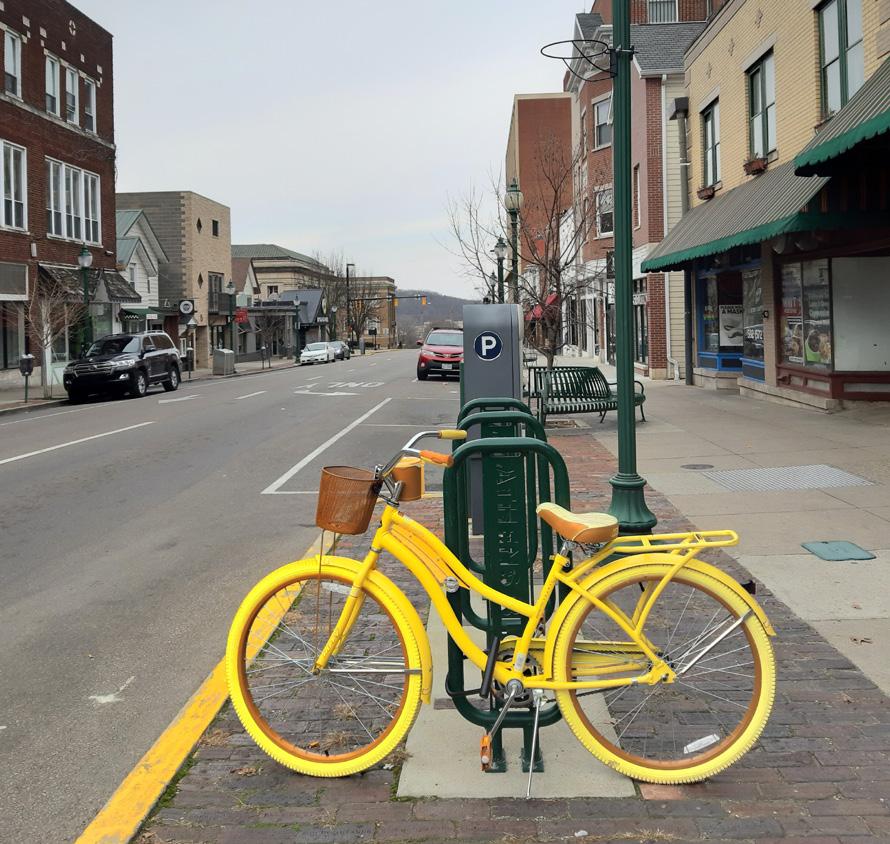



Check out these entertaining and educational events this spring.
BY RORY BALLMAY 1 FROM 9 A.M.-12 P.M.
The Tunnel to Towers Foundation is hosting its 5K run/walk to honor Stephen Siller — a 9/11 hero remembered for sacrificing his life to save people stuck in the Twin Towers. Through Siller, the symbolic figure for the Tunnel to Towers Foundation, runners and walkers alike can honor the nations military heroes and first responders. The race is from 9:00 am to 12:00 pm and begins at the Nelsonville Historic Public Square and registration costs $30.
This year, the Athens Farmers Market is celebrating its 50th Anniversary starting June 4 and will last through the fall. Every Wednesday from 9 a.m. to 12 p.m., April to June, Athens Farmers Market will offer locally sourced produce, meats, cheeses, pastries and breads, wines and ciders and much more! Local artists in Athens County from the Athens Art Guild will also be selling their paintings, jewelry, pottery, clothes and furniture. SNAP/EBT are also accepted!
JULY 23, 3:30 P.M.-8 P.M.
Friends of the Shelter Dogs is hosting its 7th annual Cruise in for the Shelter Dogs July 23 from 3:30 p.m. to 8:30 p.m. The Friends of the Shelter Dogs is a non-profit organization that provides veterinary support for dogs in the Athens County Dog Shelter. Held at the Market on State, the event is open to all classic cars, motorcycles, trucks and campers. The upfront $10 donation goes to supporting dogs in the shelter and donators can enjoy delicious food. The event also features live music, raffles, prizes, food and adoptable dogs!
The 6th annual Pawpaw 4 Miler will be held in Lake Snowden in Albany on Sept. 18 from 8 a.m. to 10 a.m. The 4 Miler and the one hour fun run/walk will work with the Ohio Pawpaw Festival, a popular 24-year tradition in southeast Ohio. The 4 Miler is a cross-country style race in the scenic Lake Snowden, and offers a mixture of trail, grass and obstacle running that is perfect for serious runners, families and children alike.